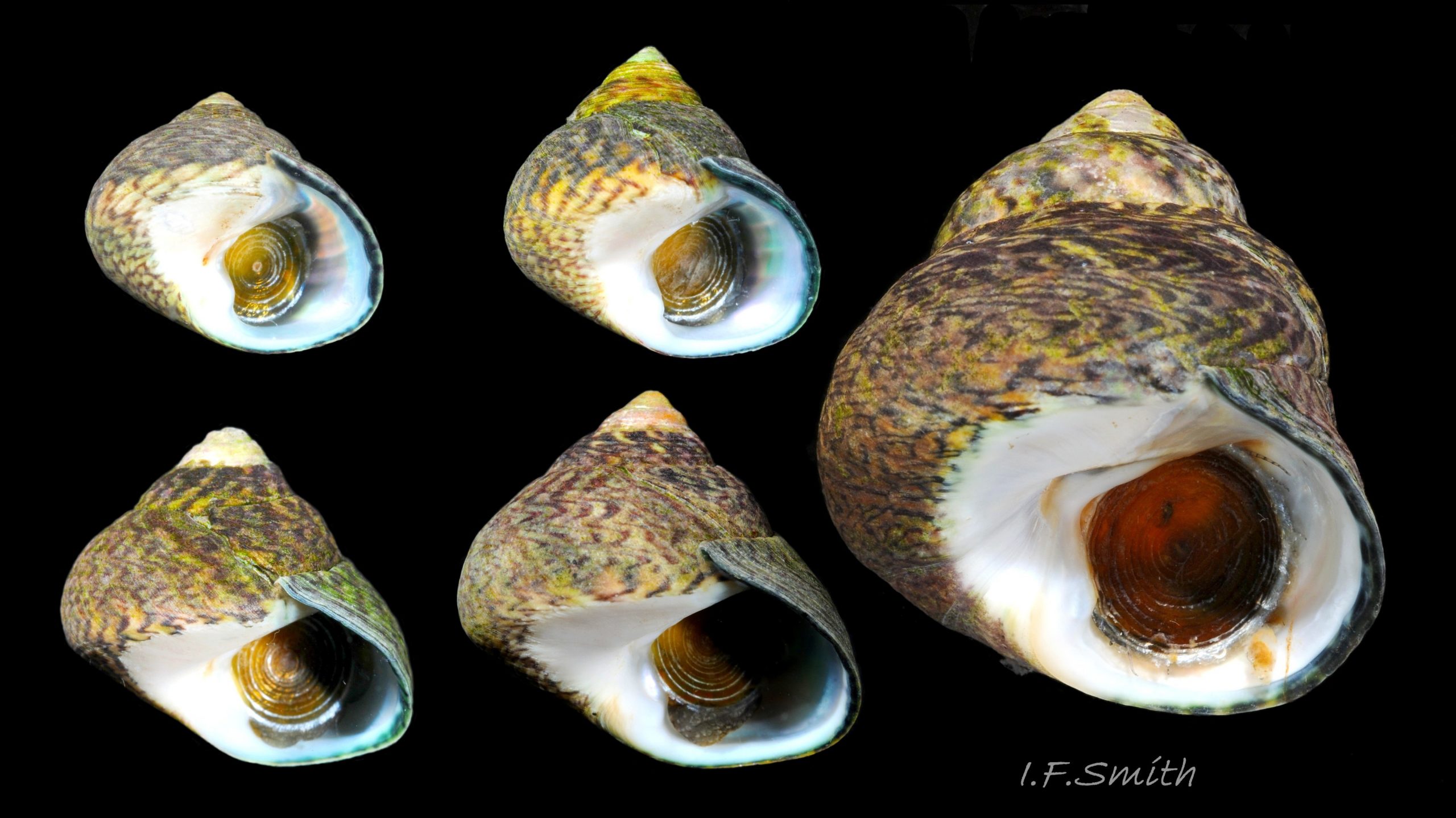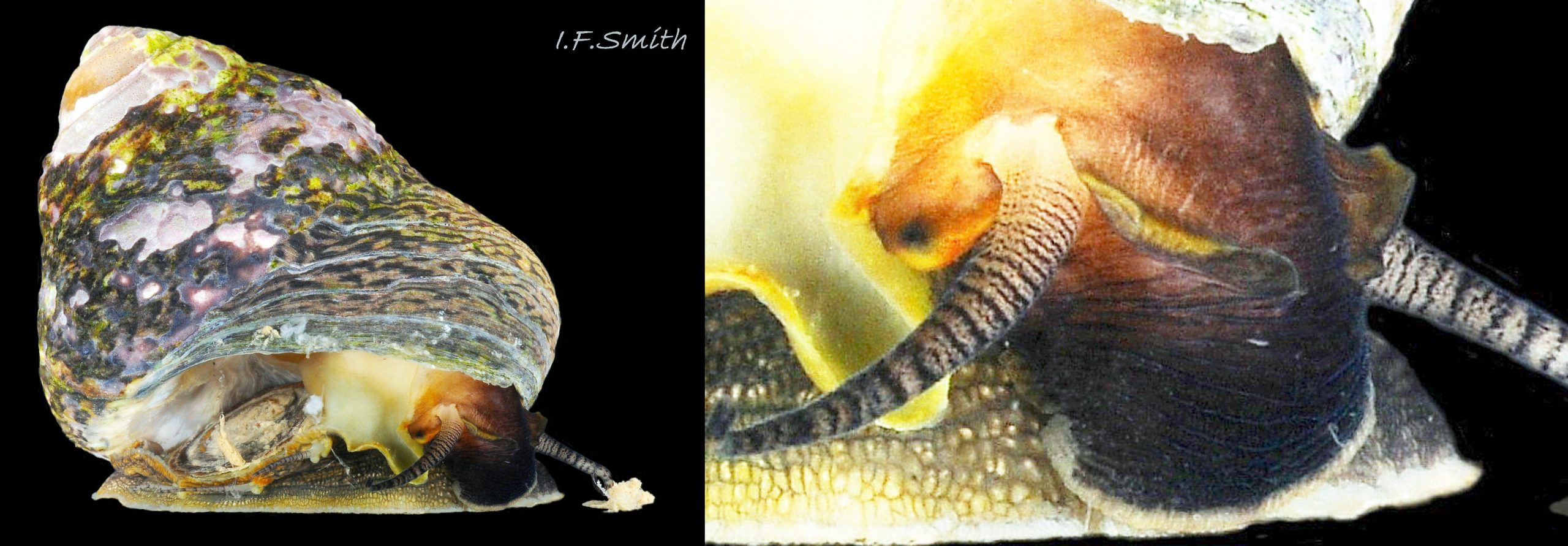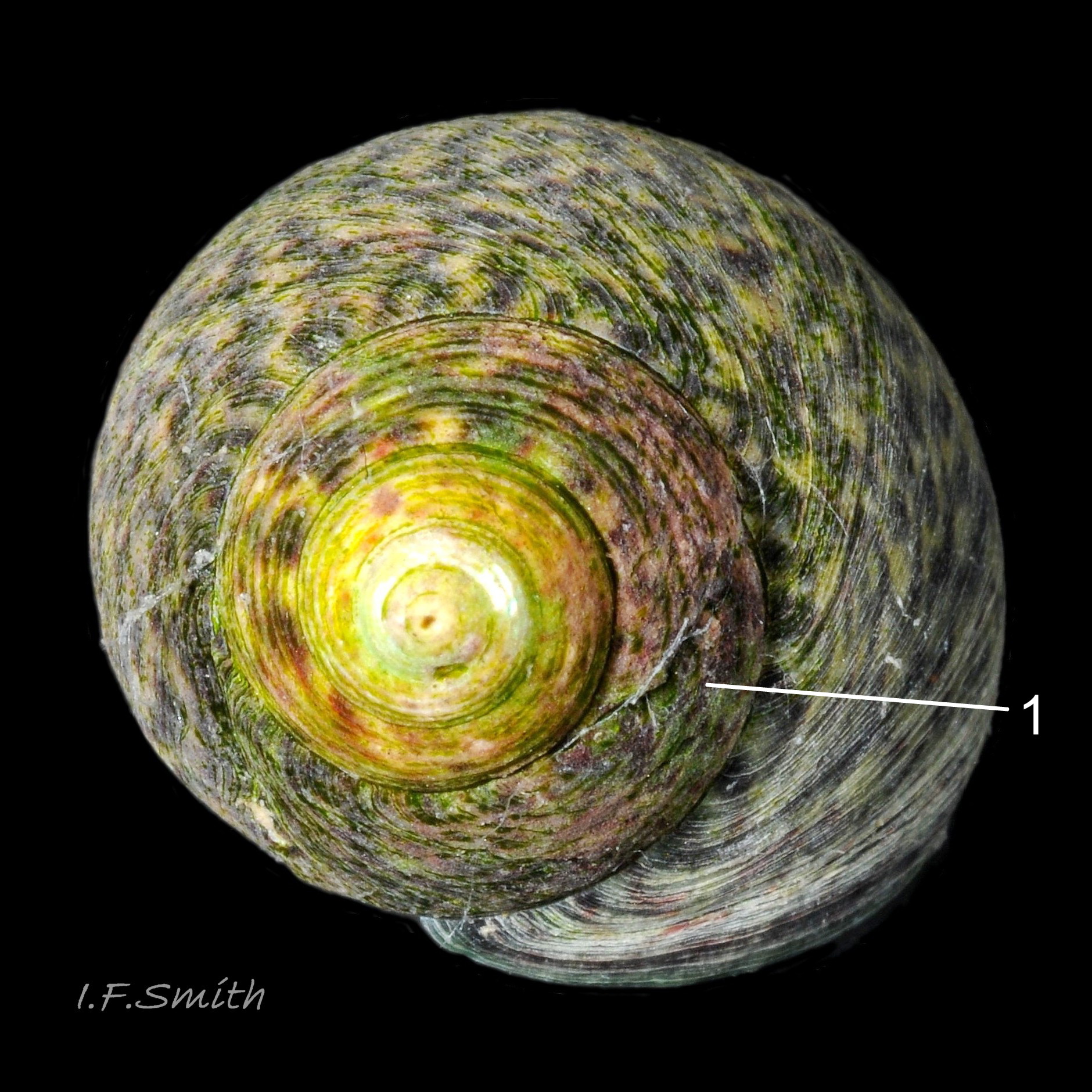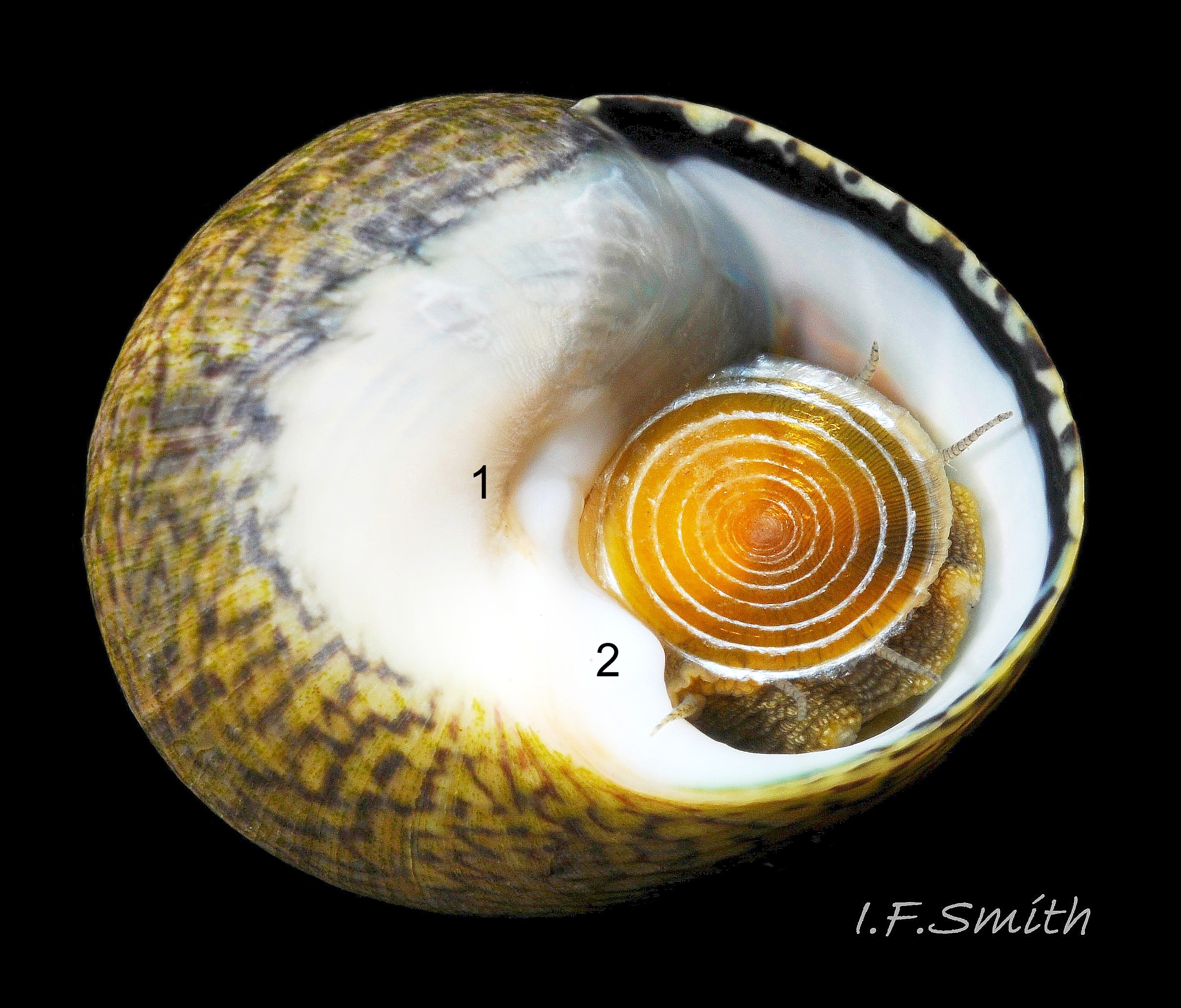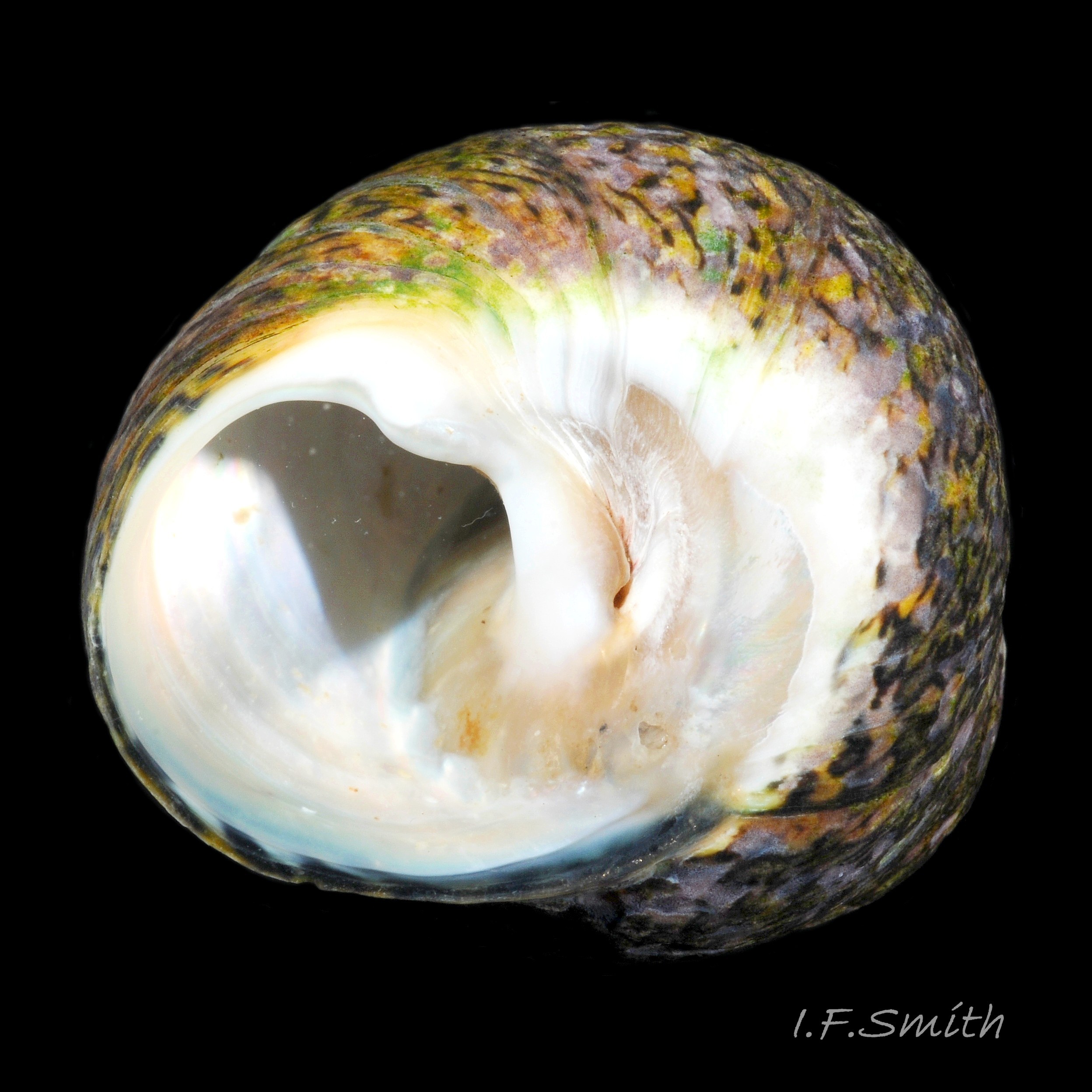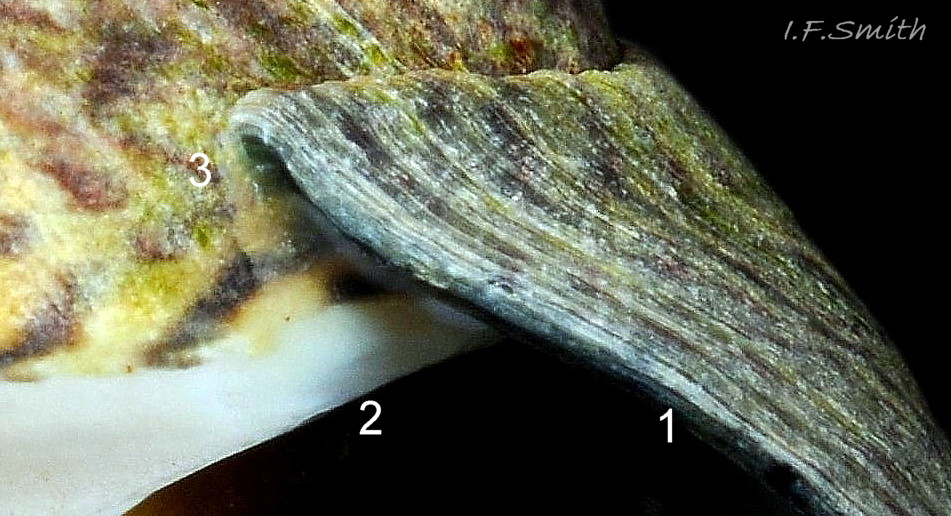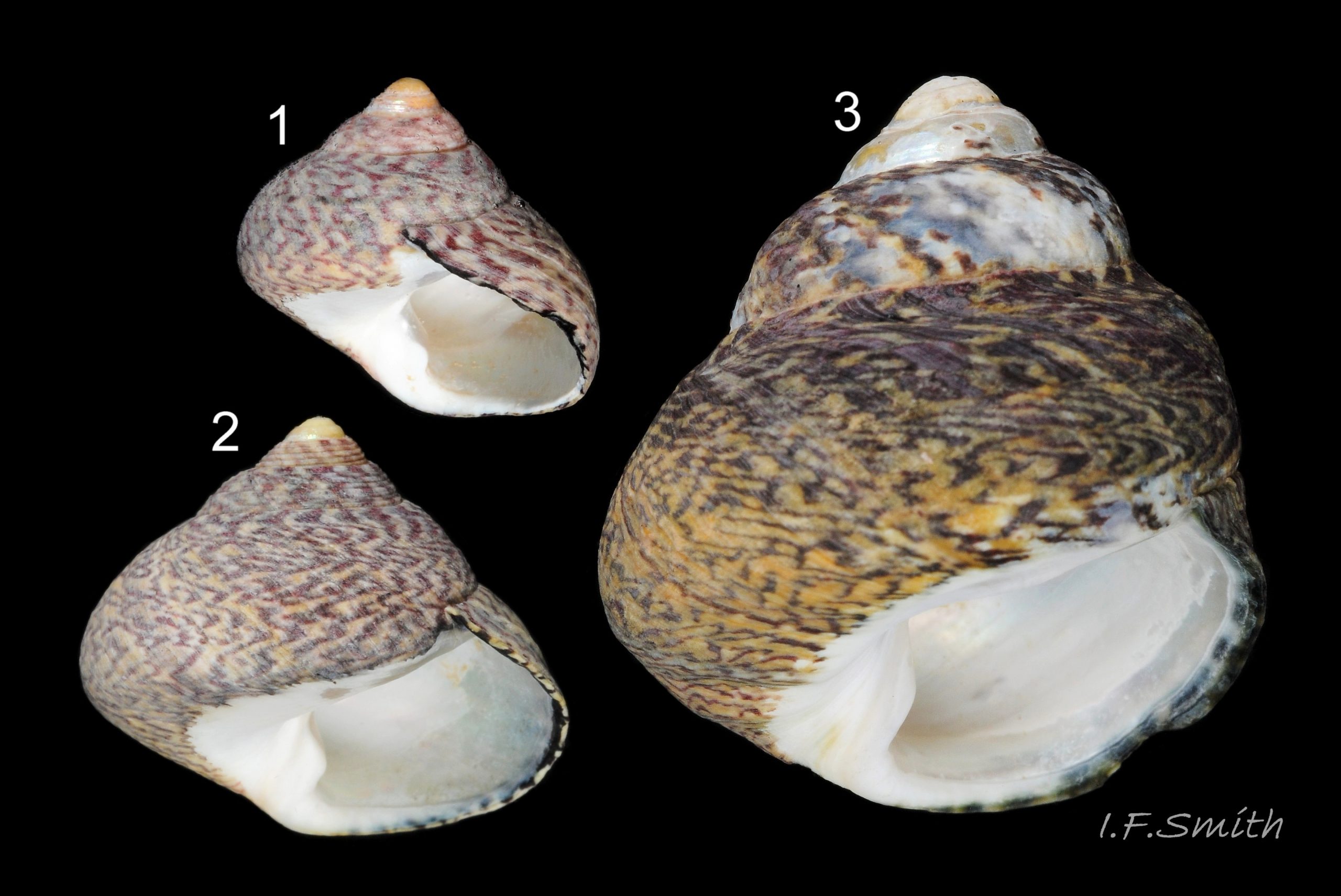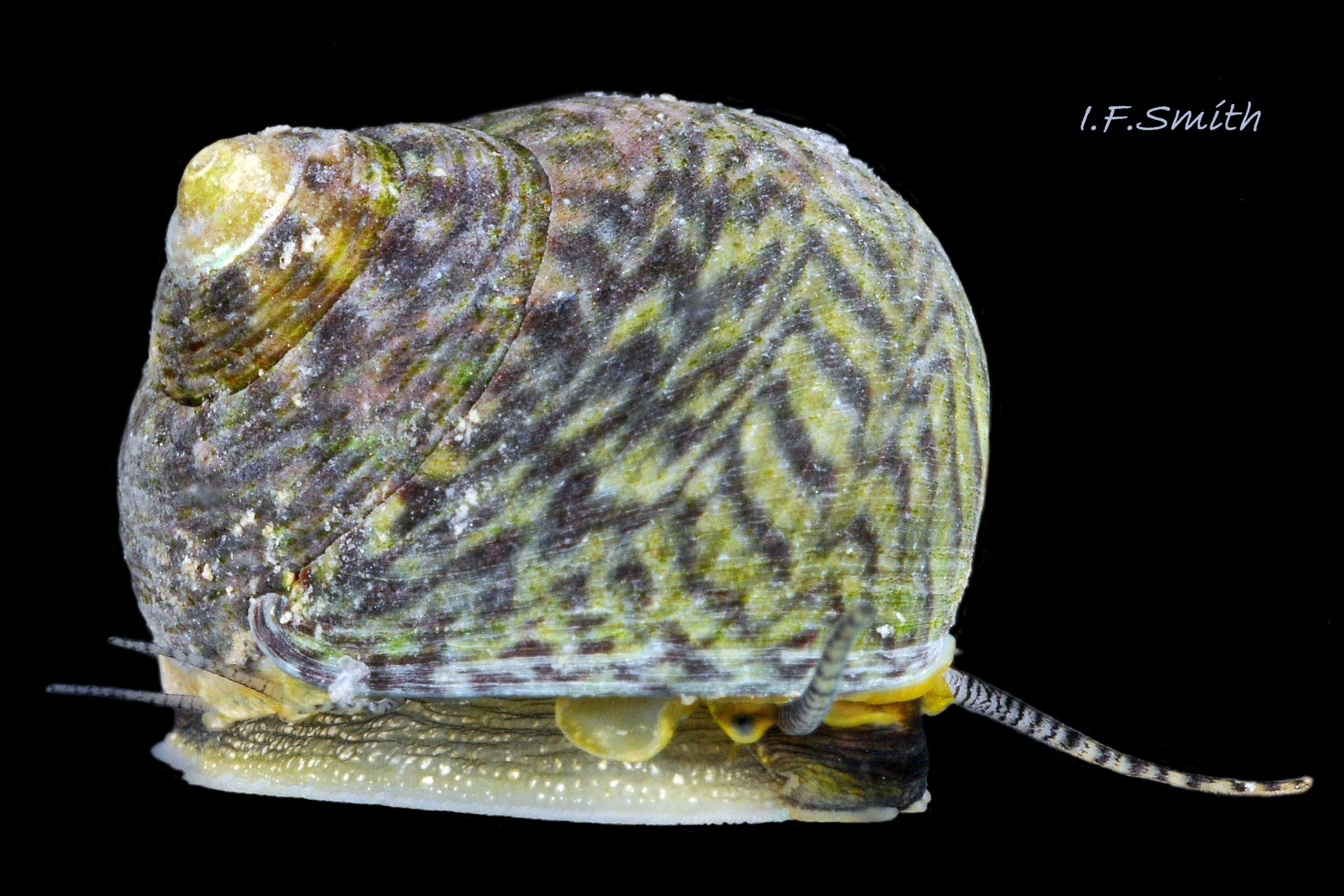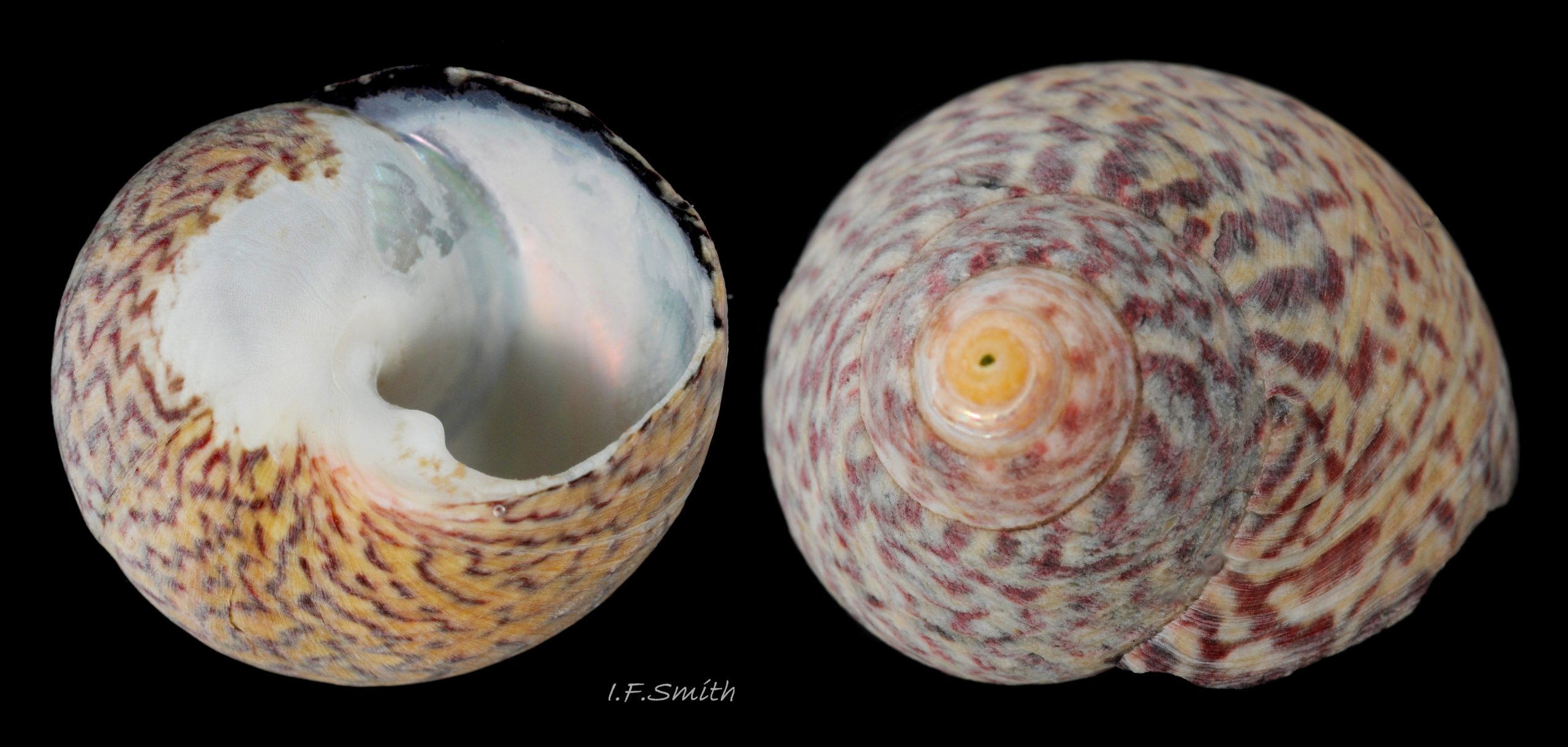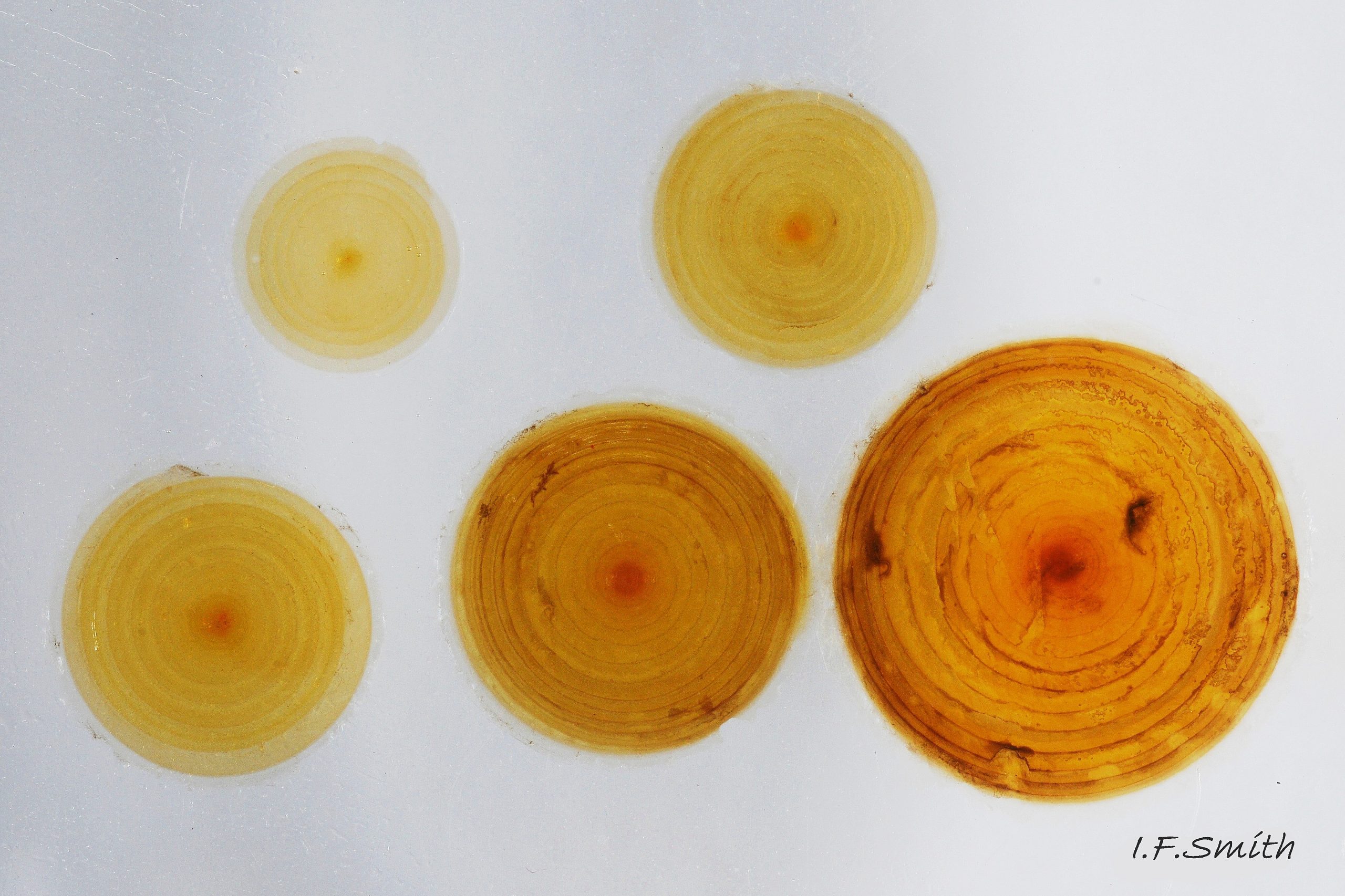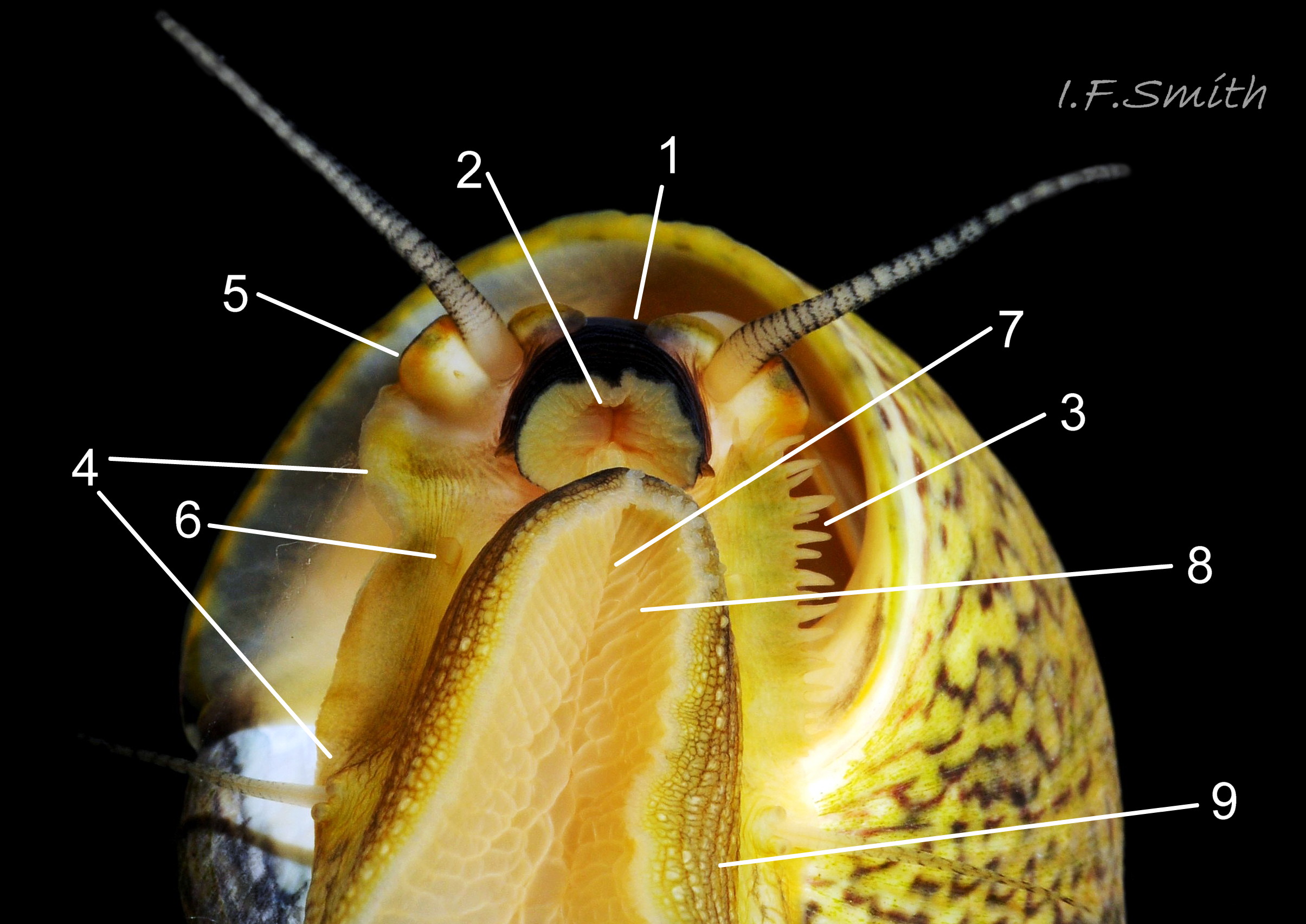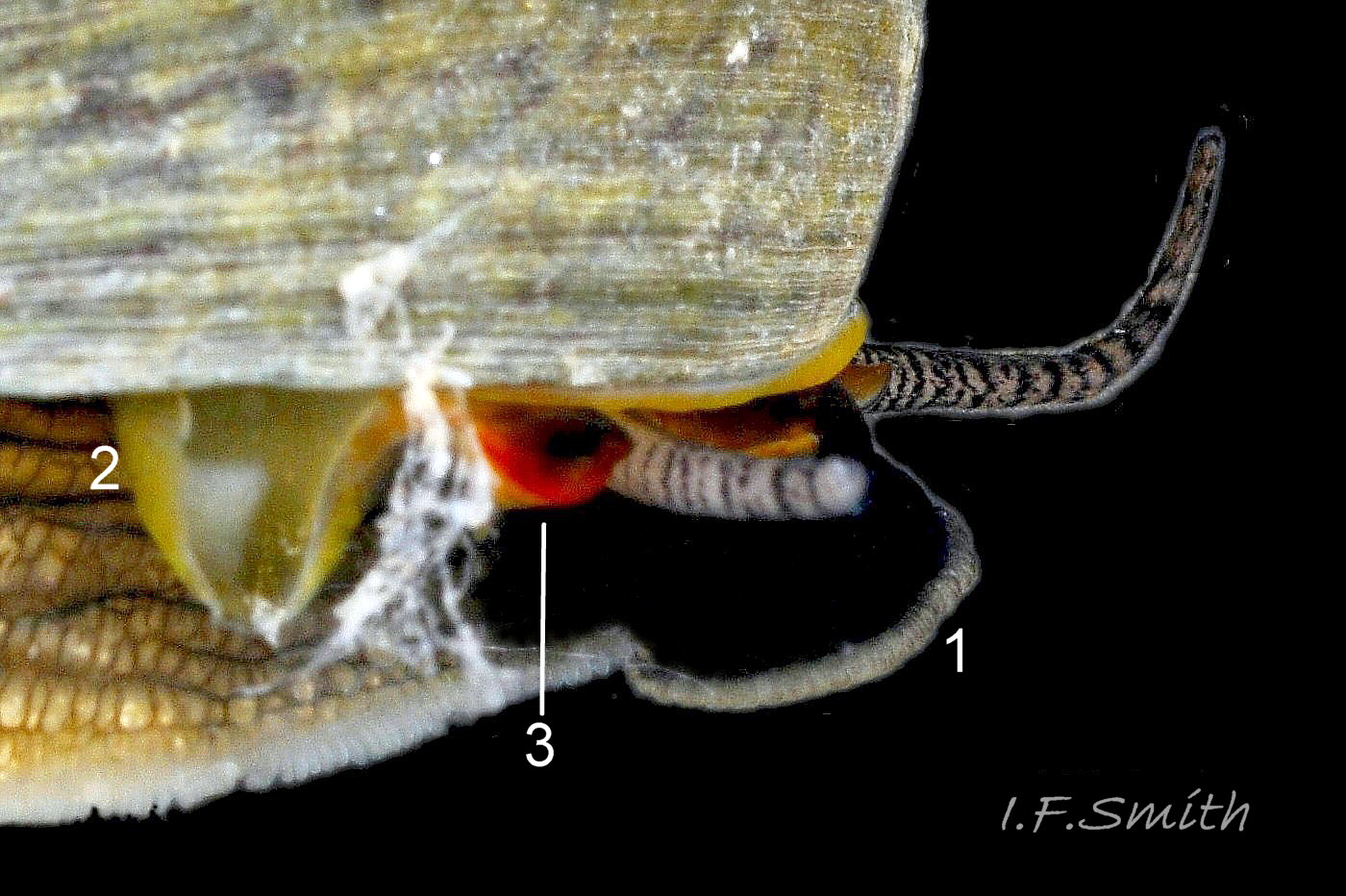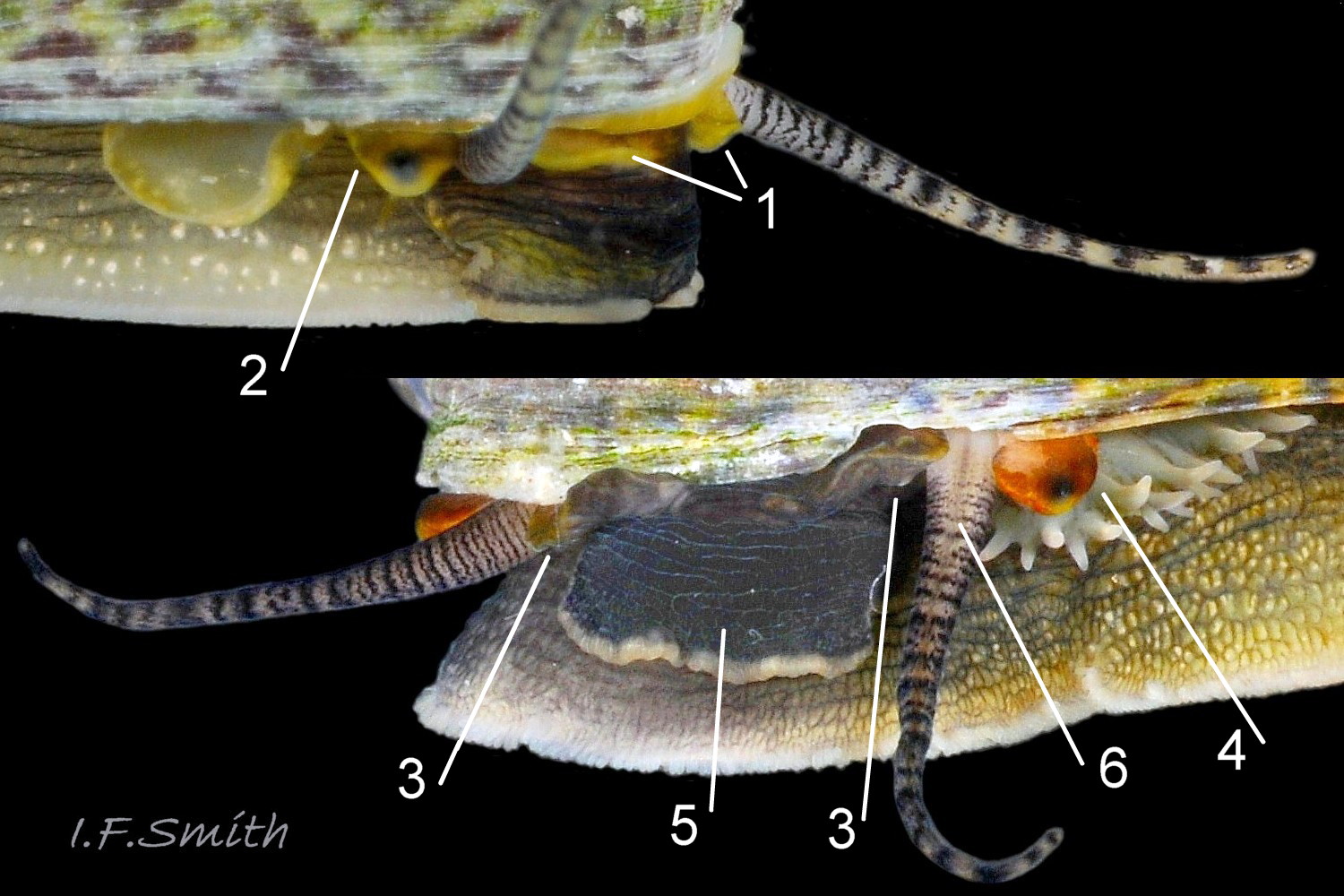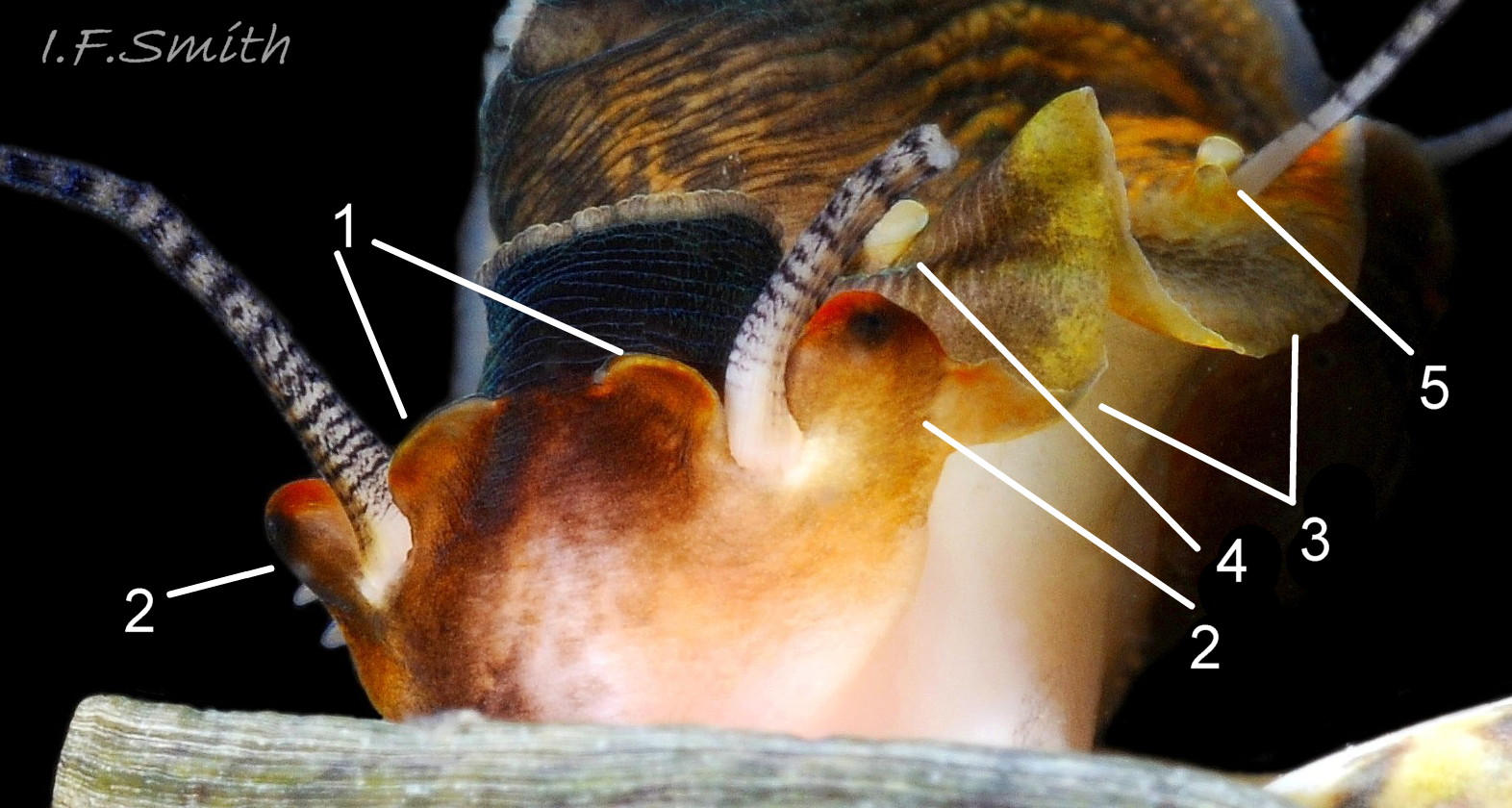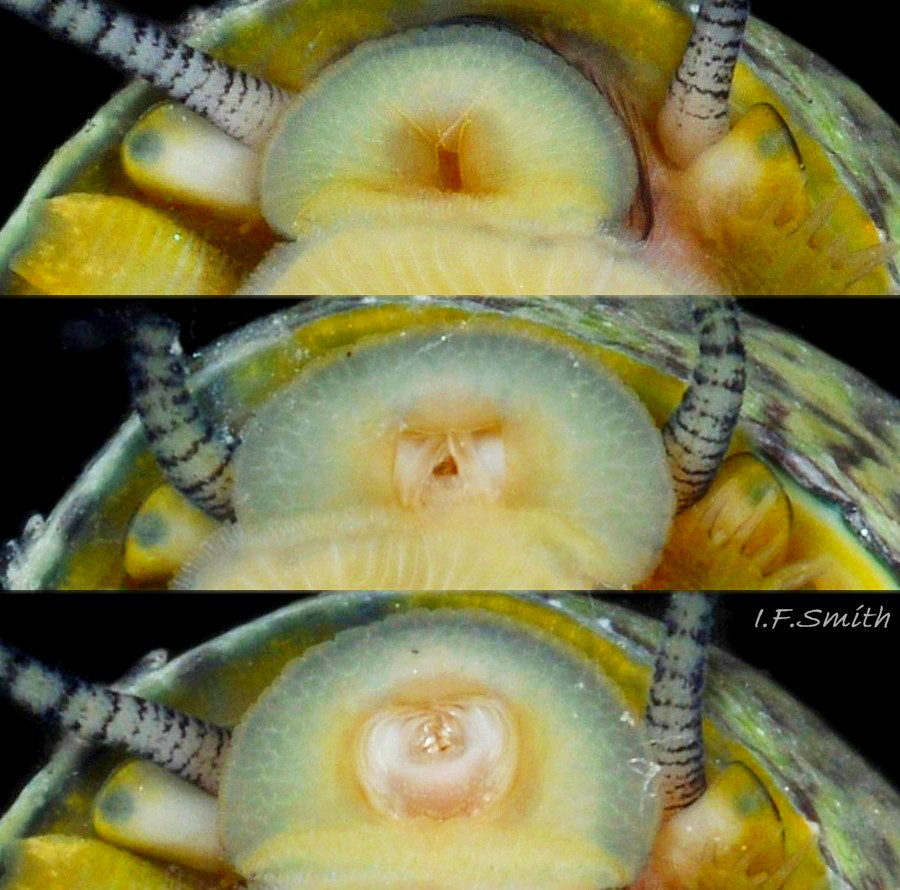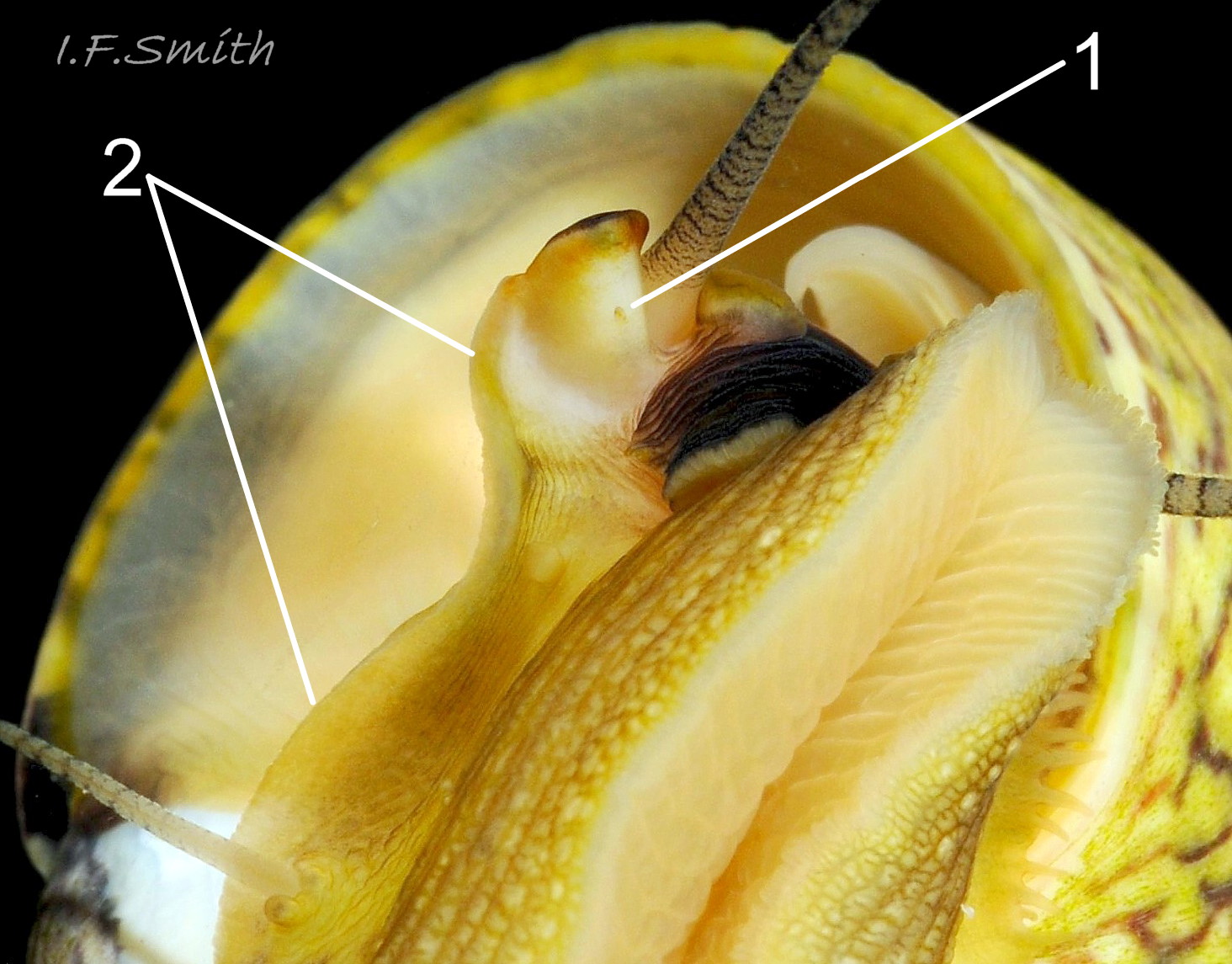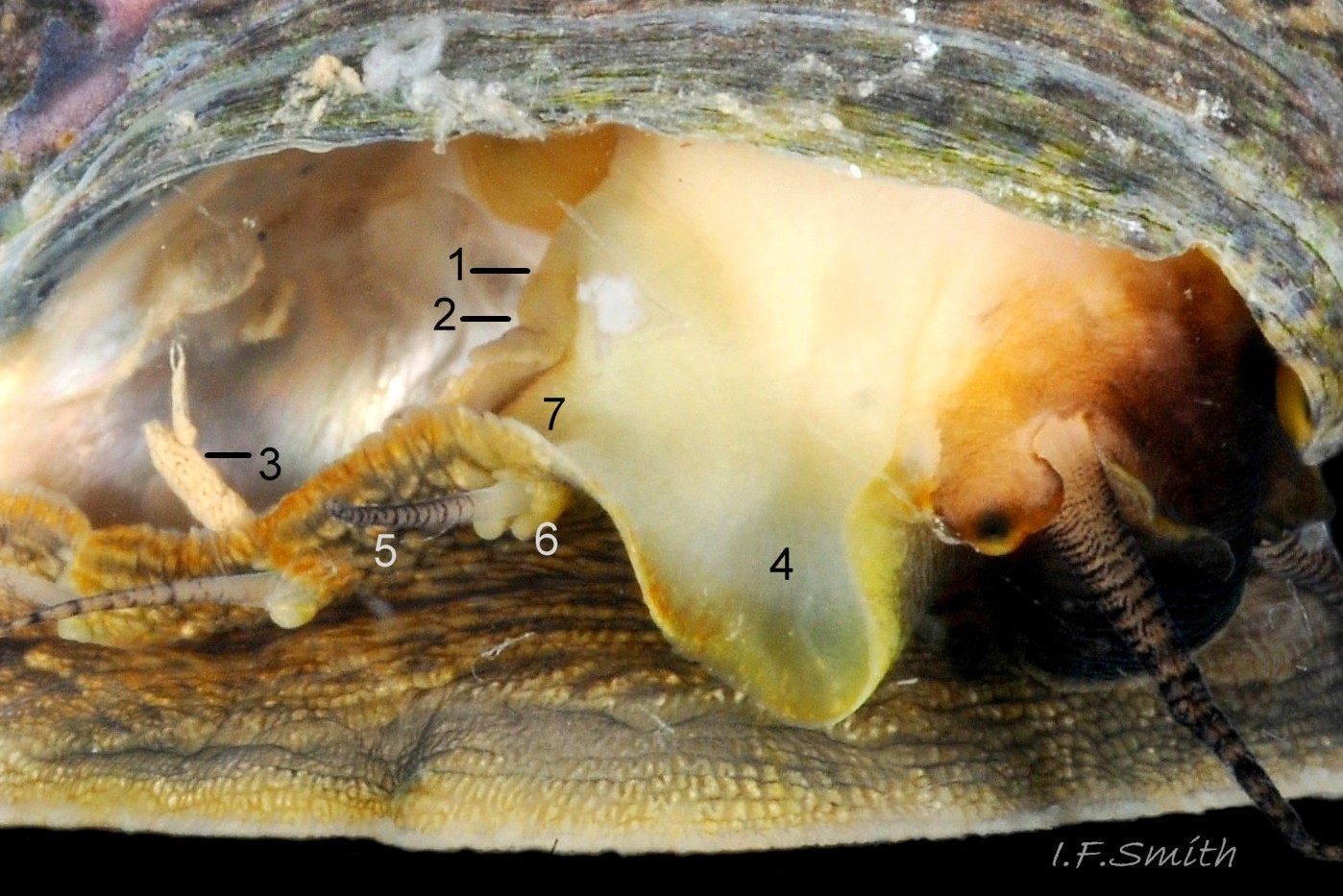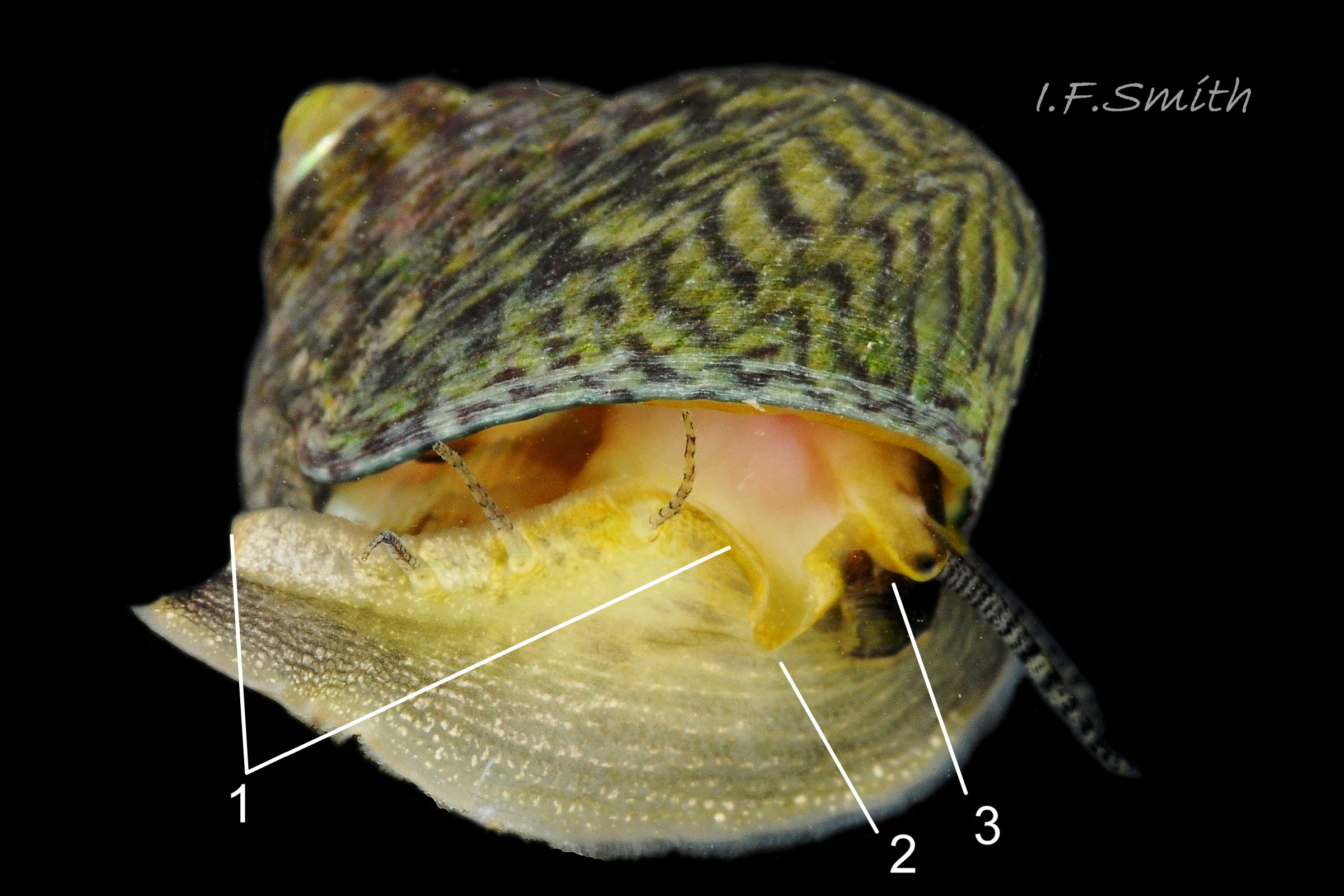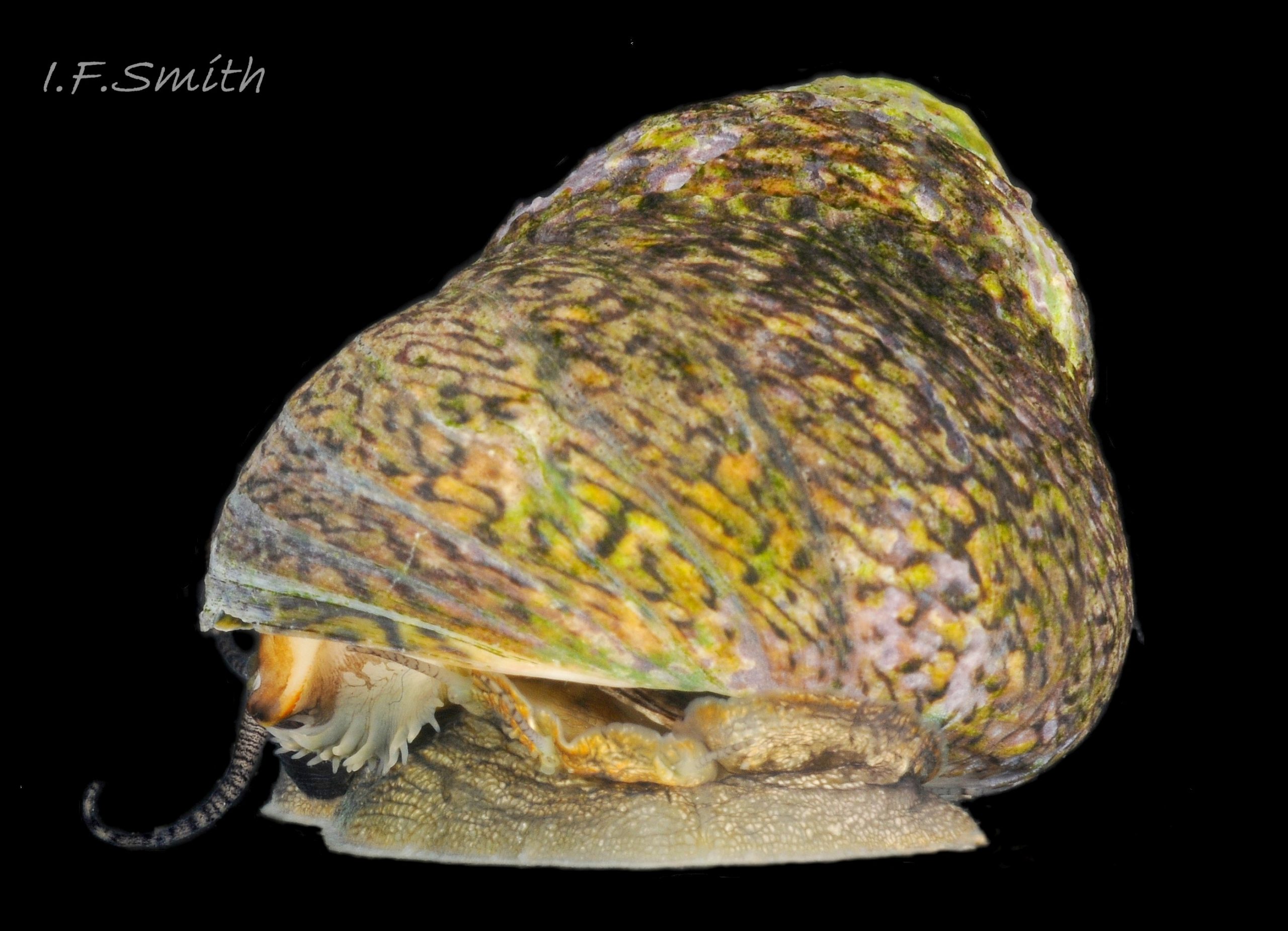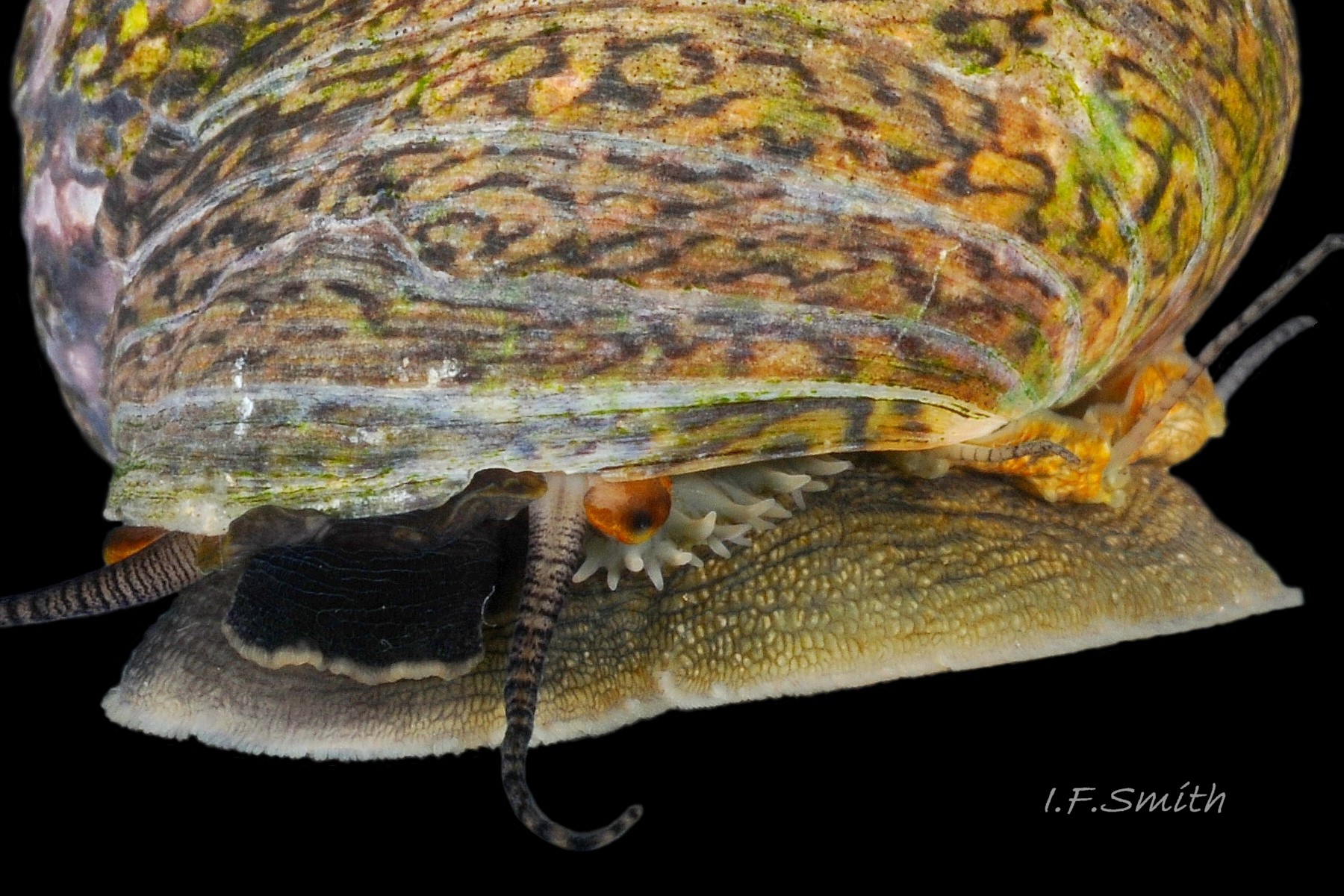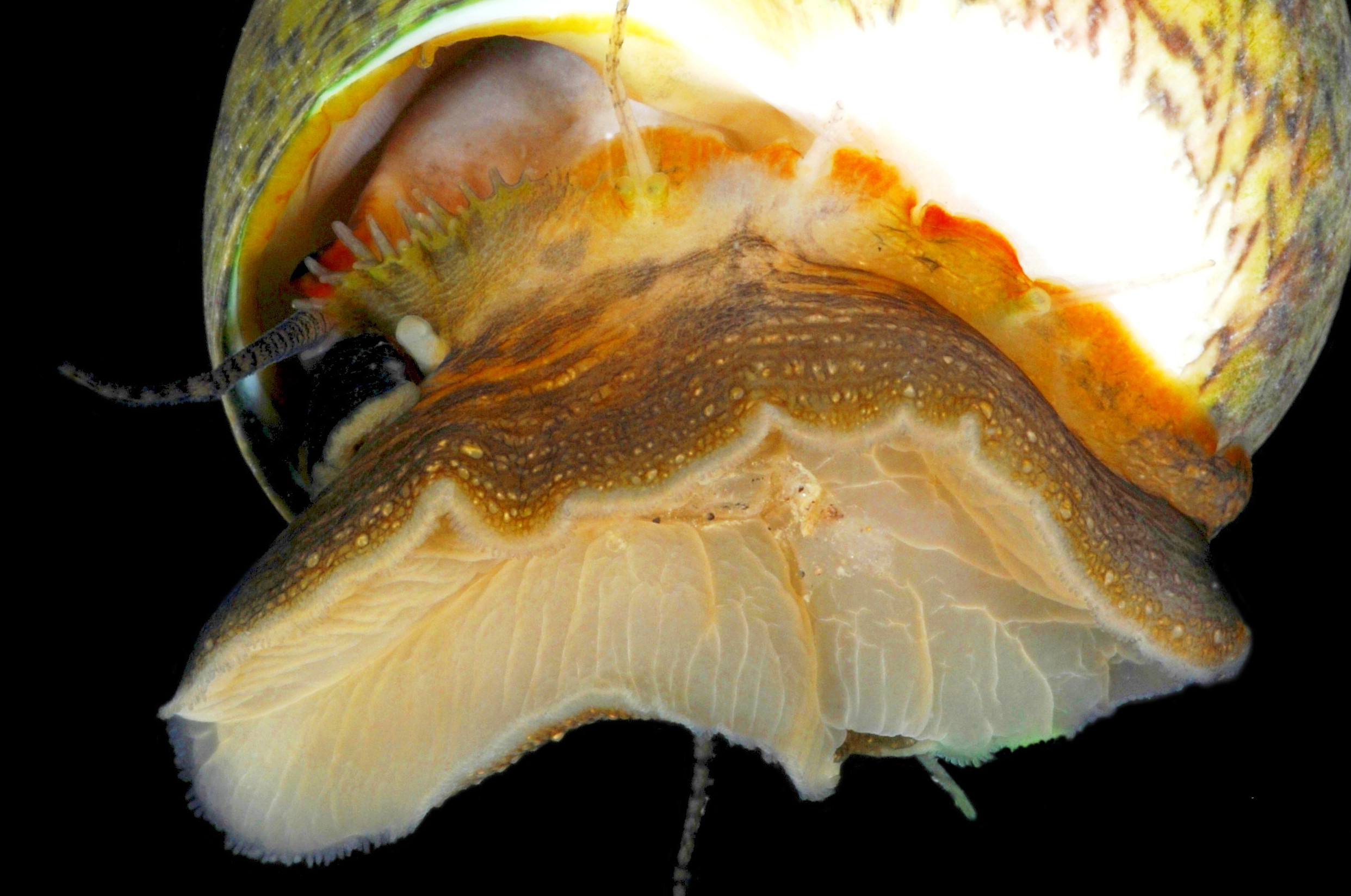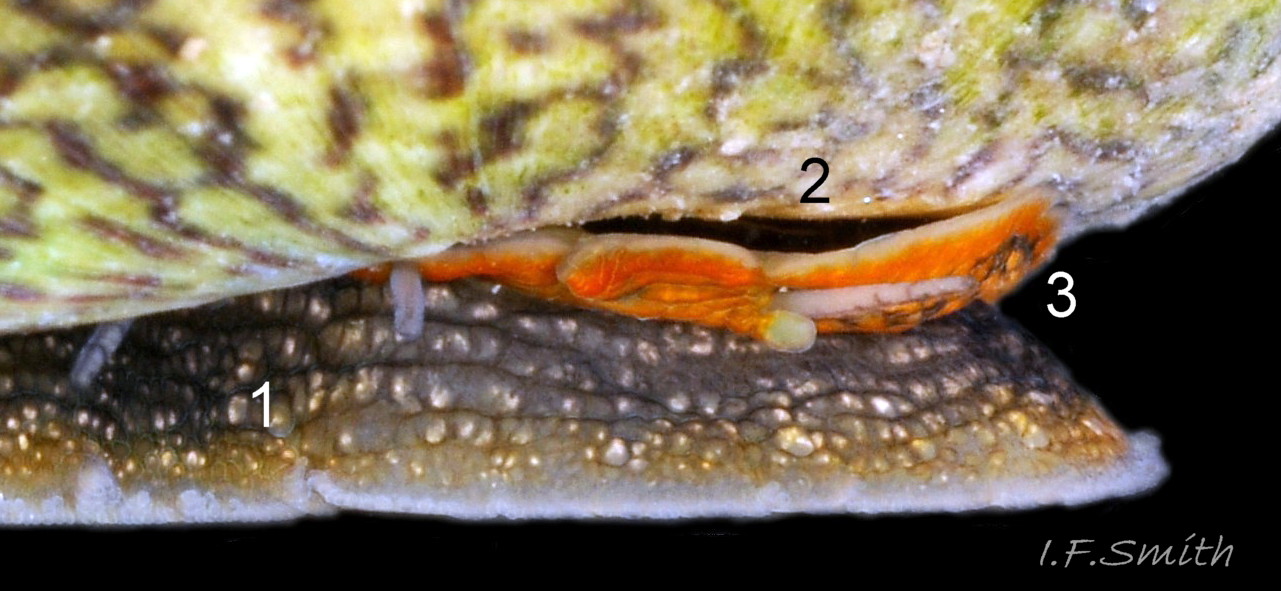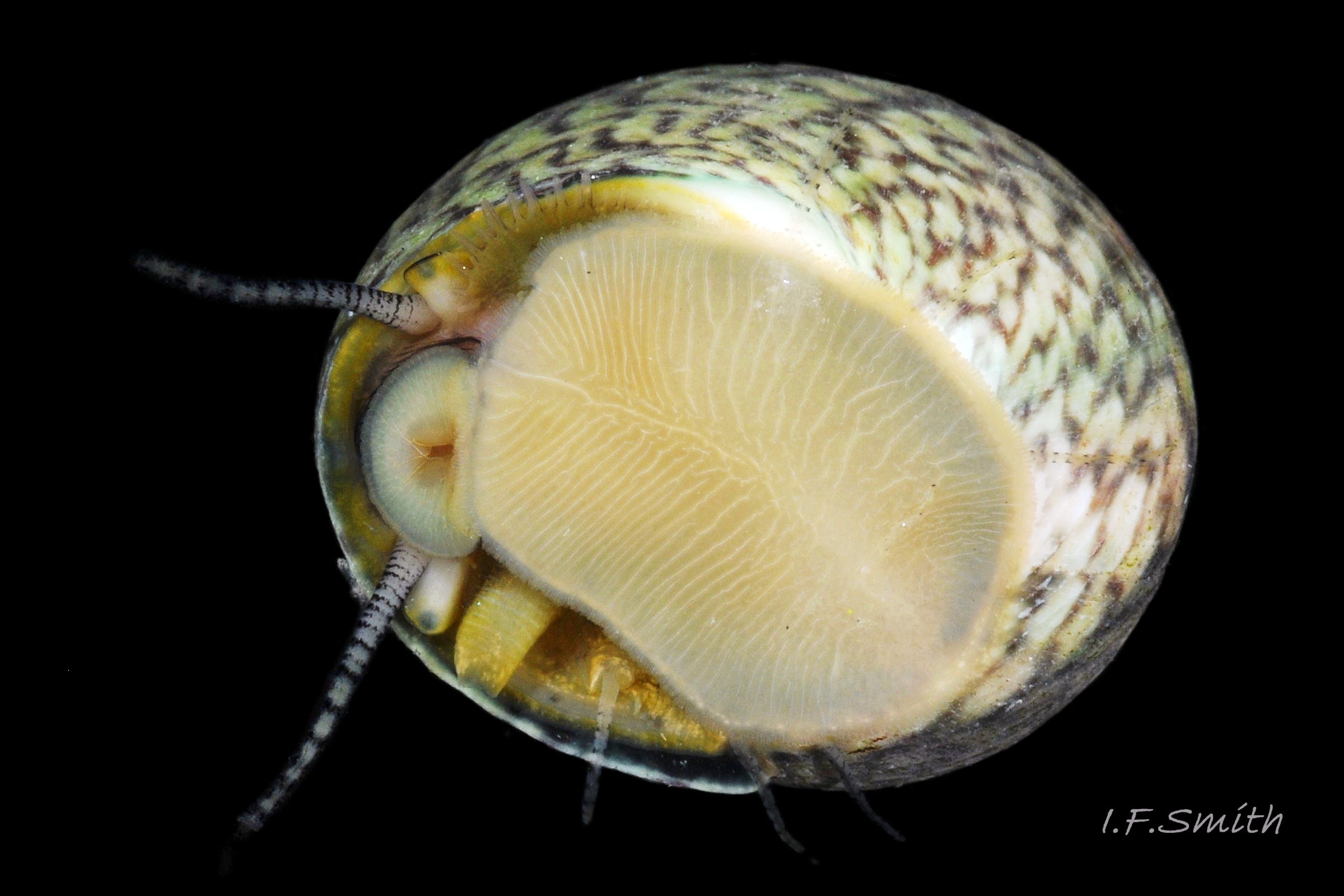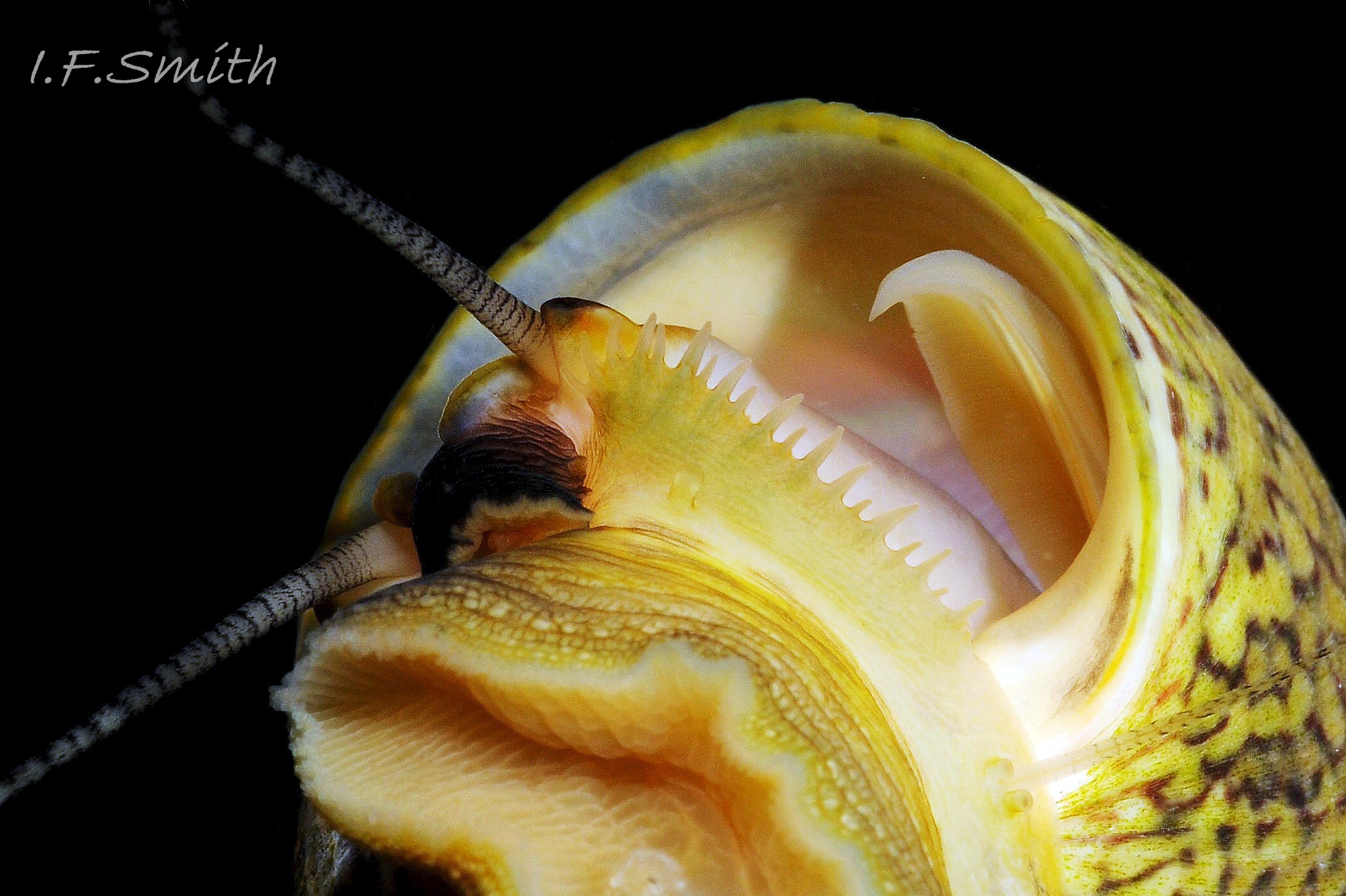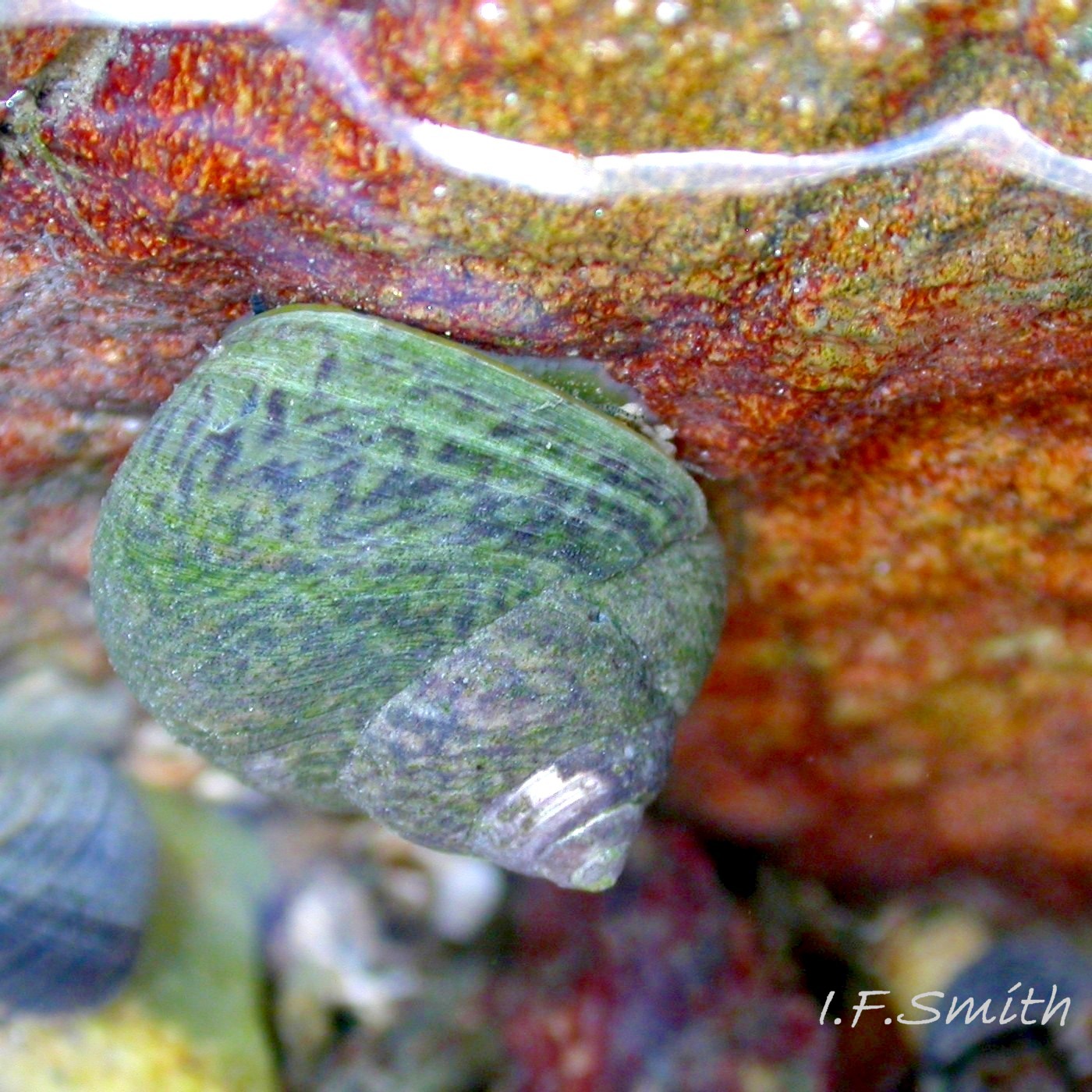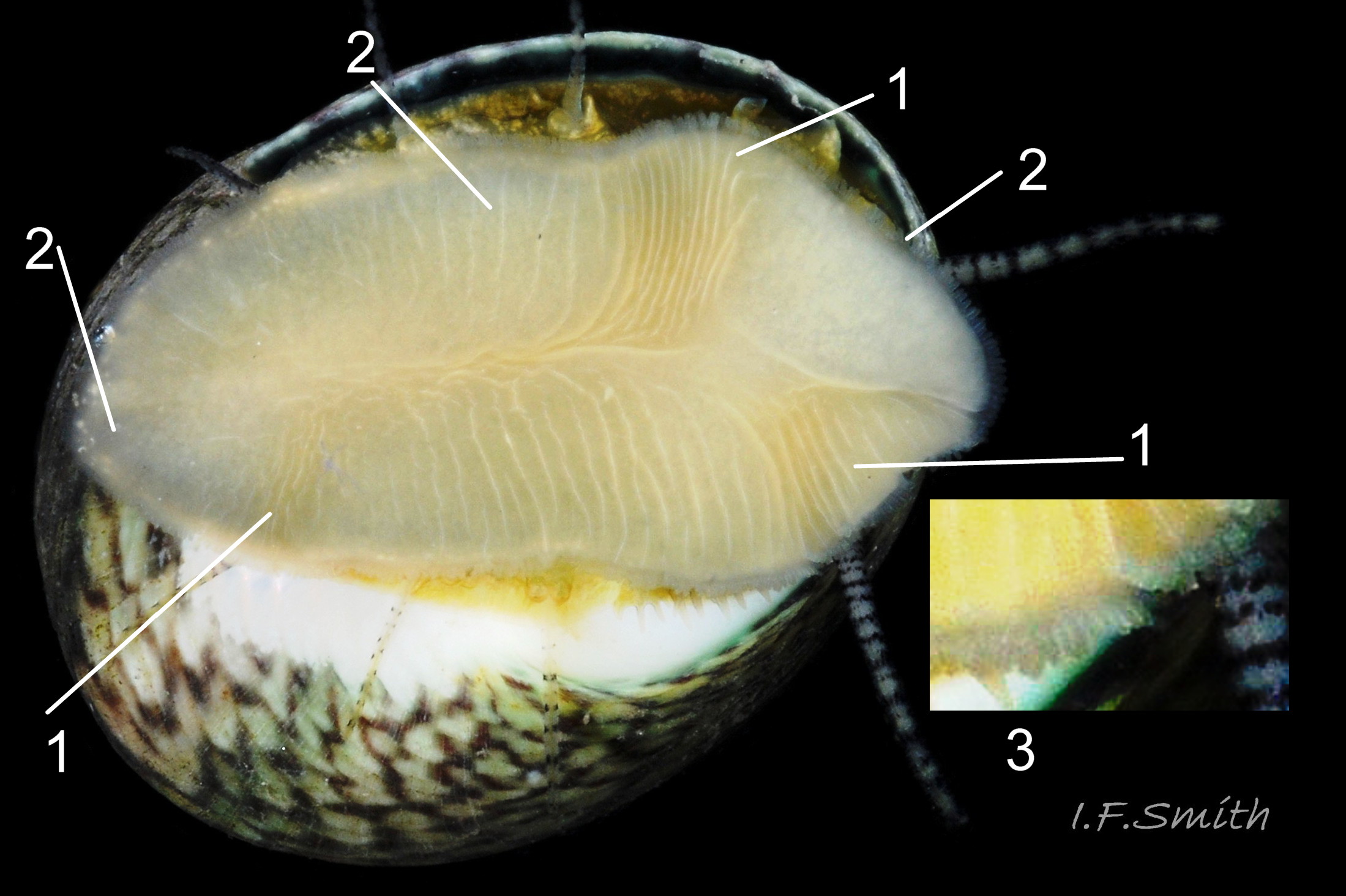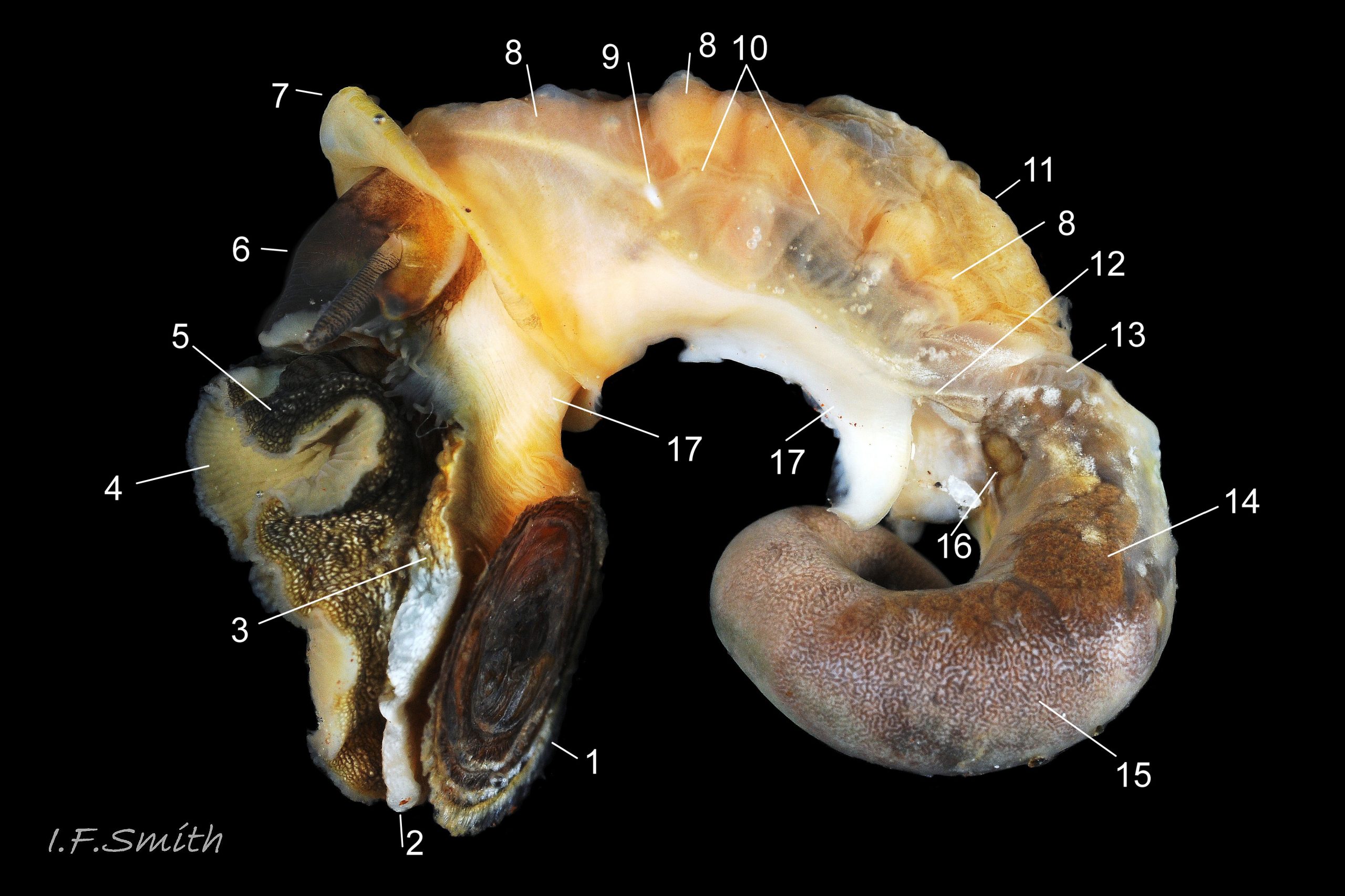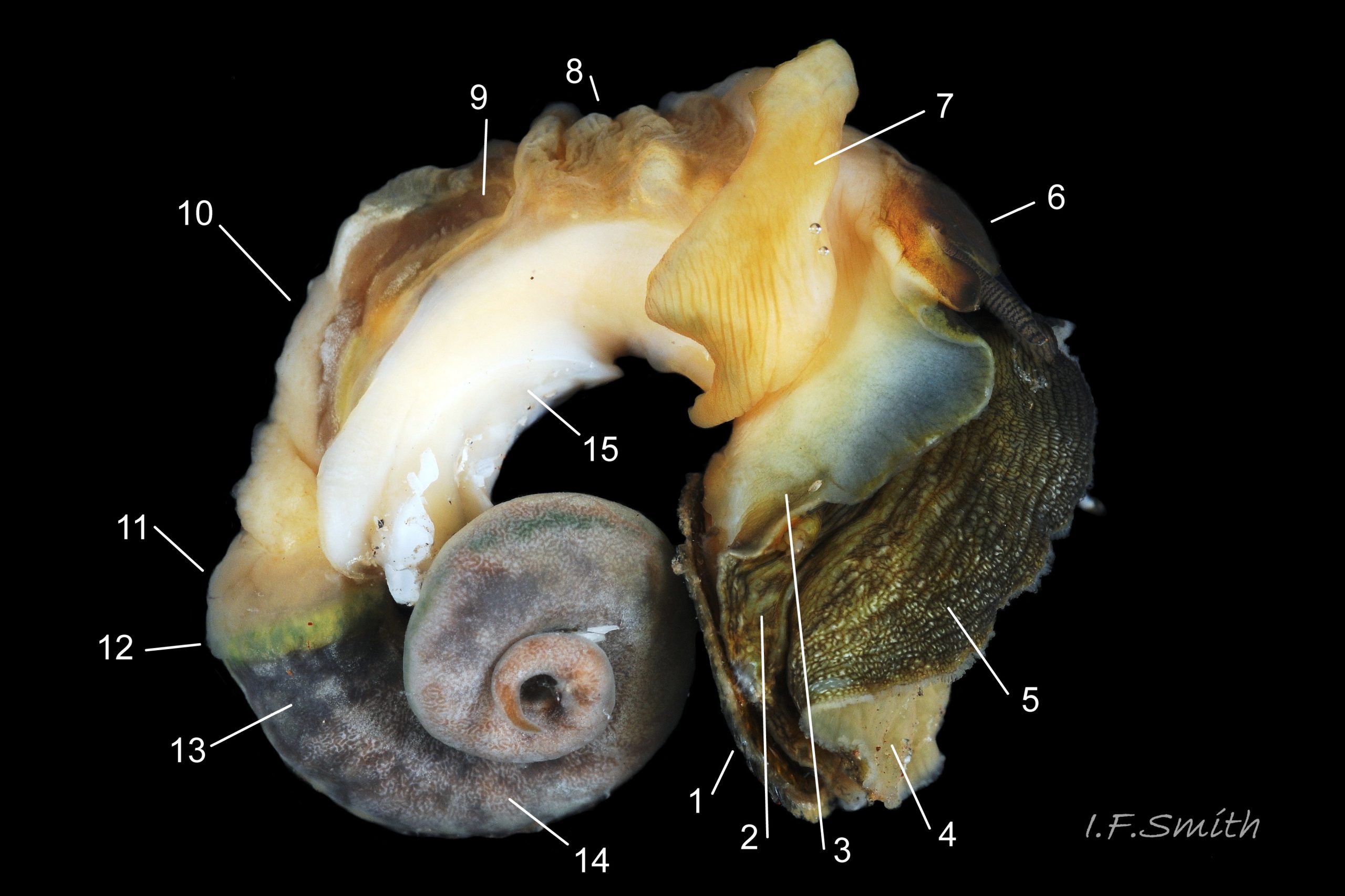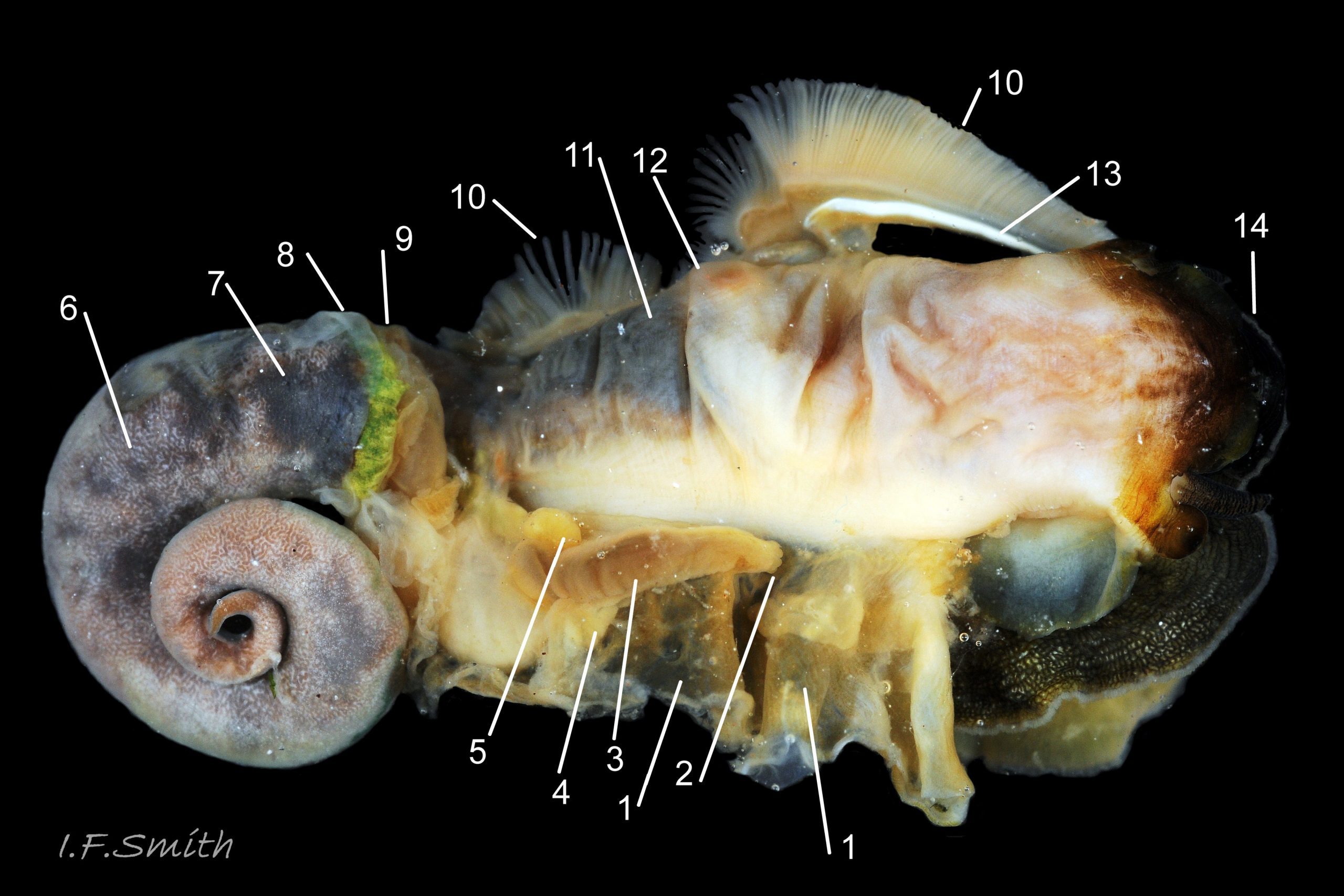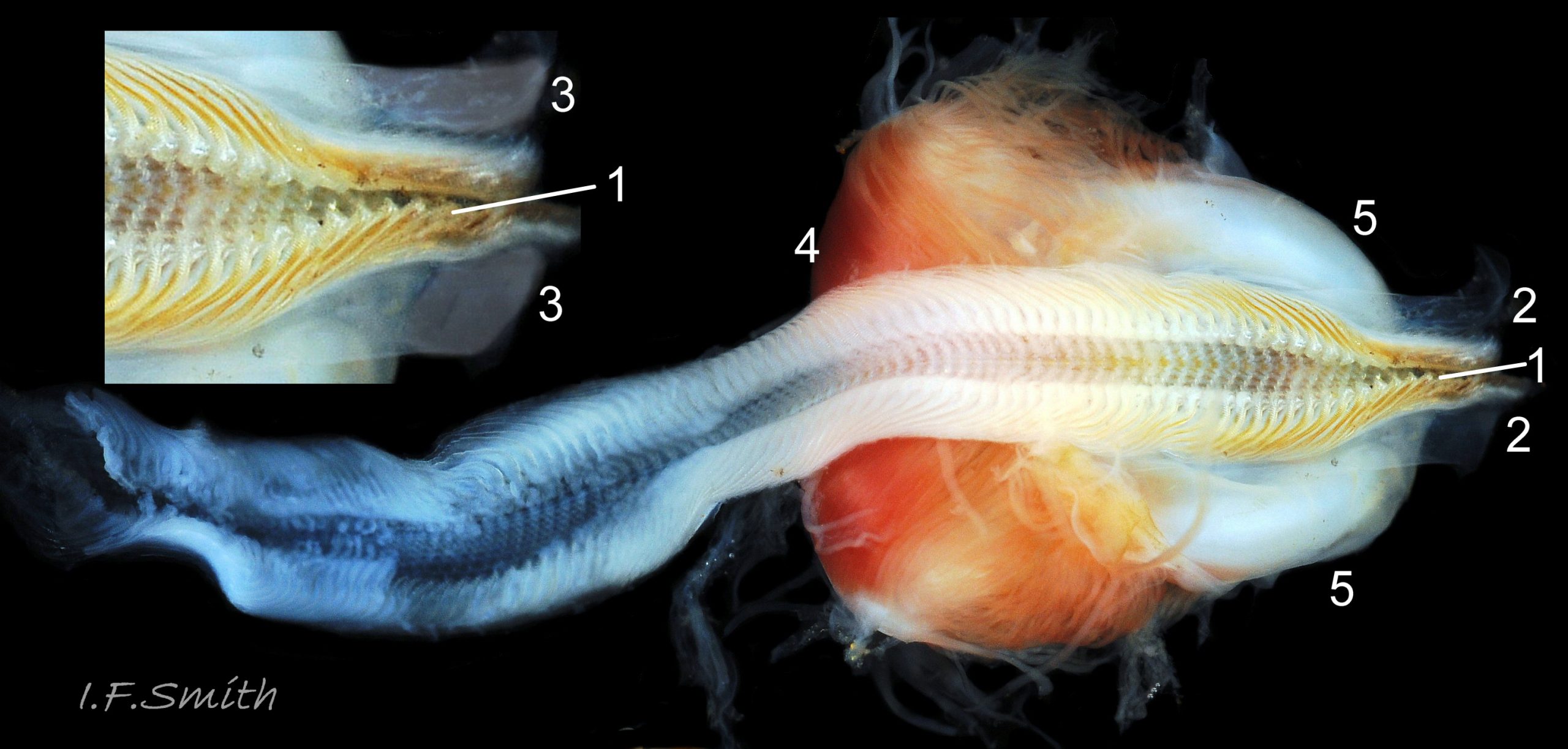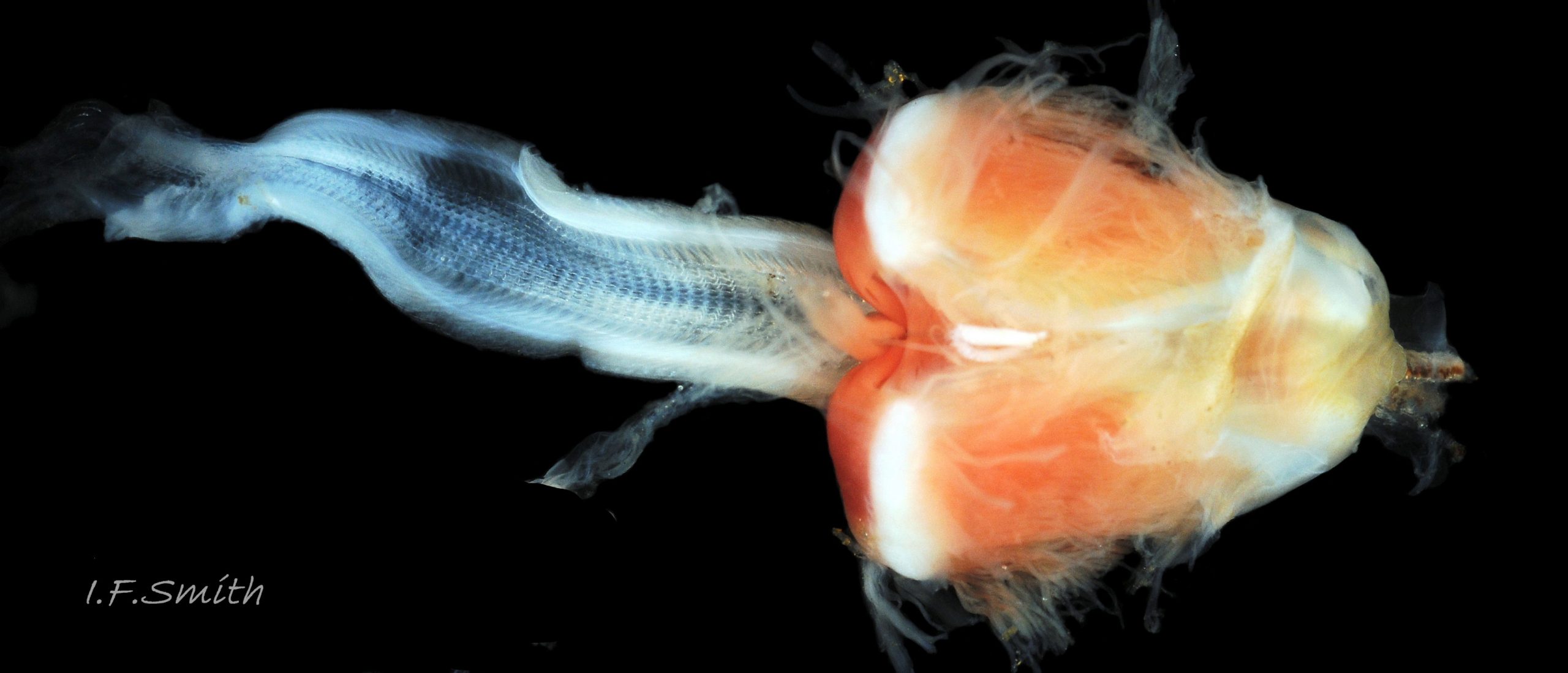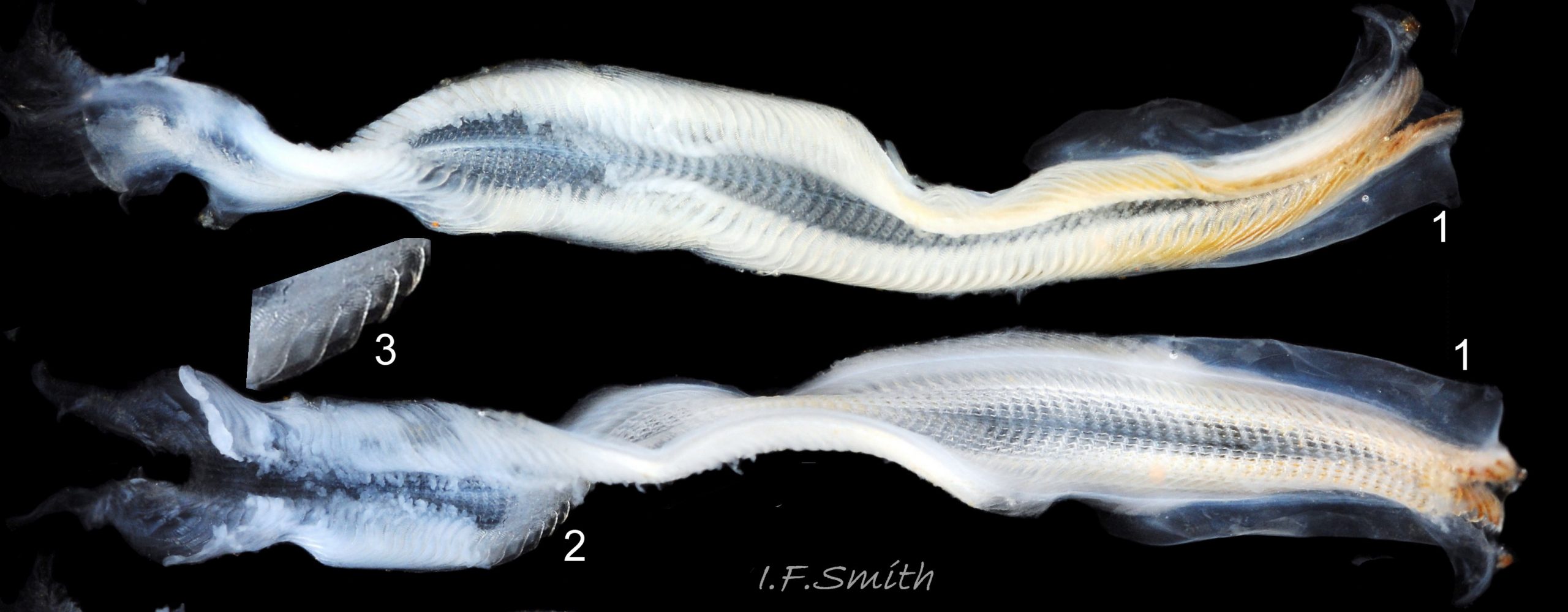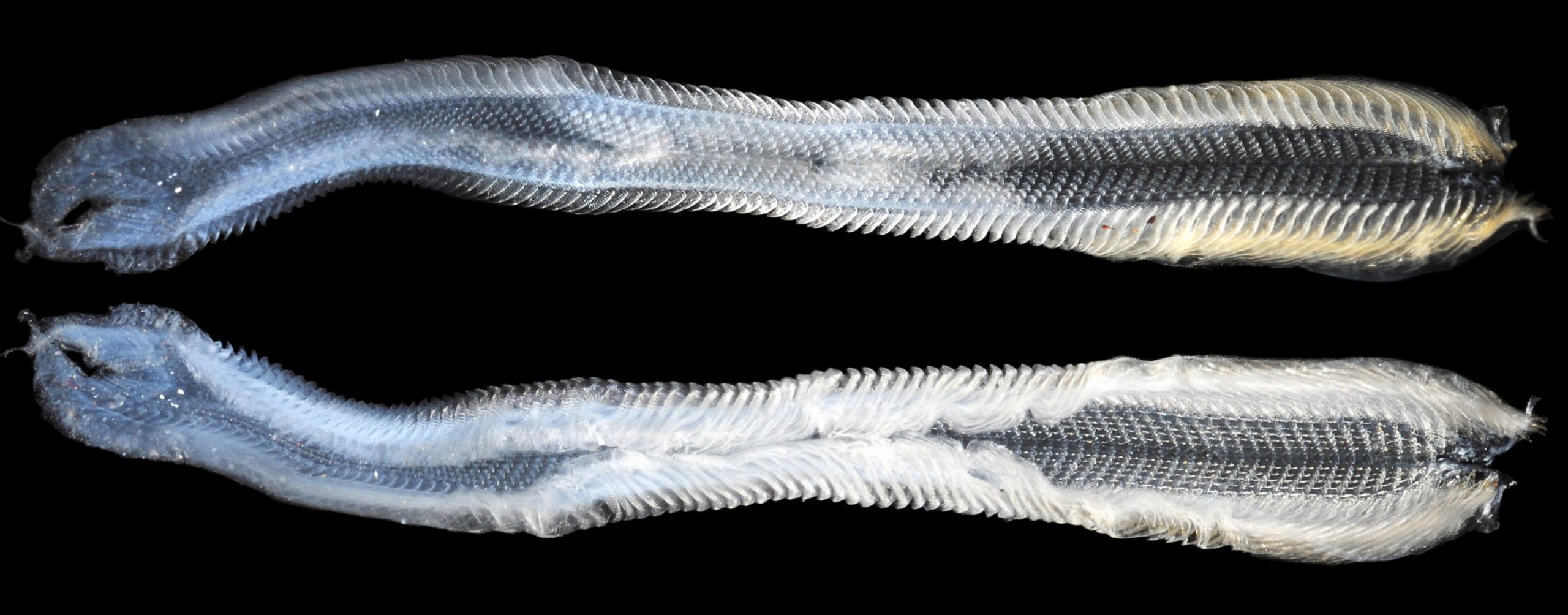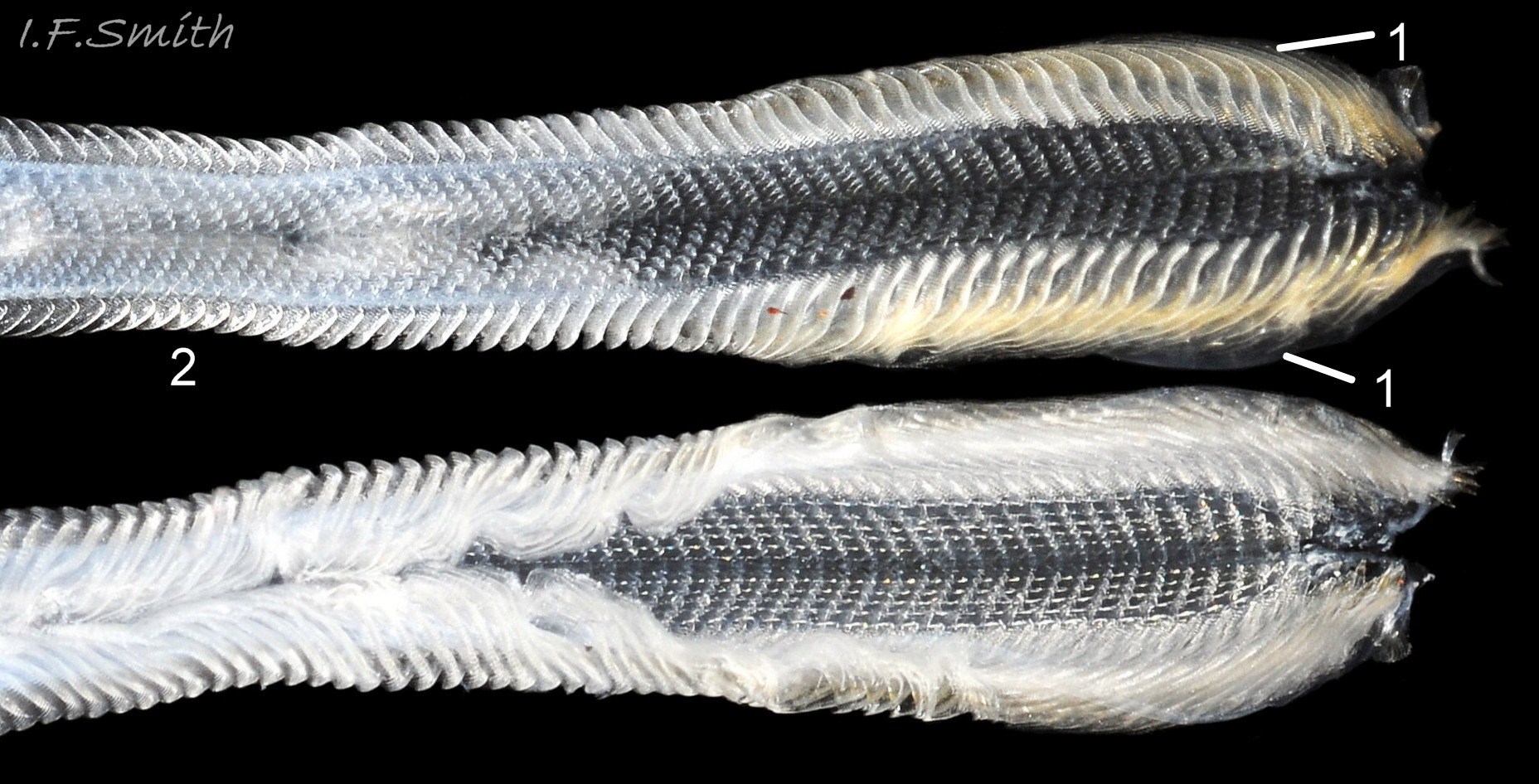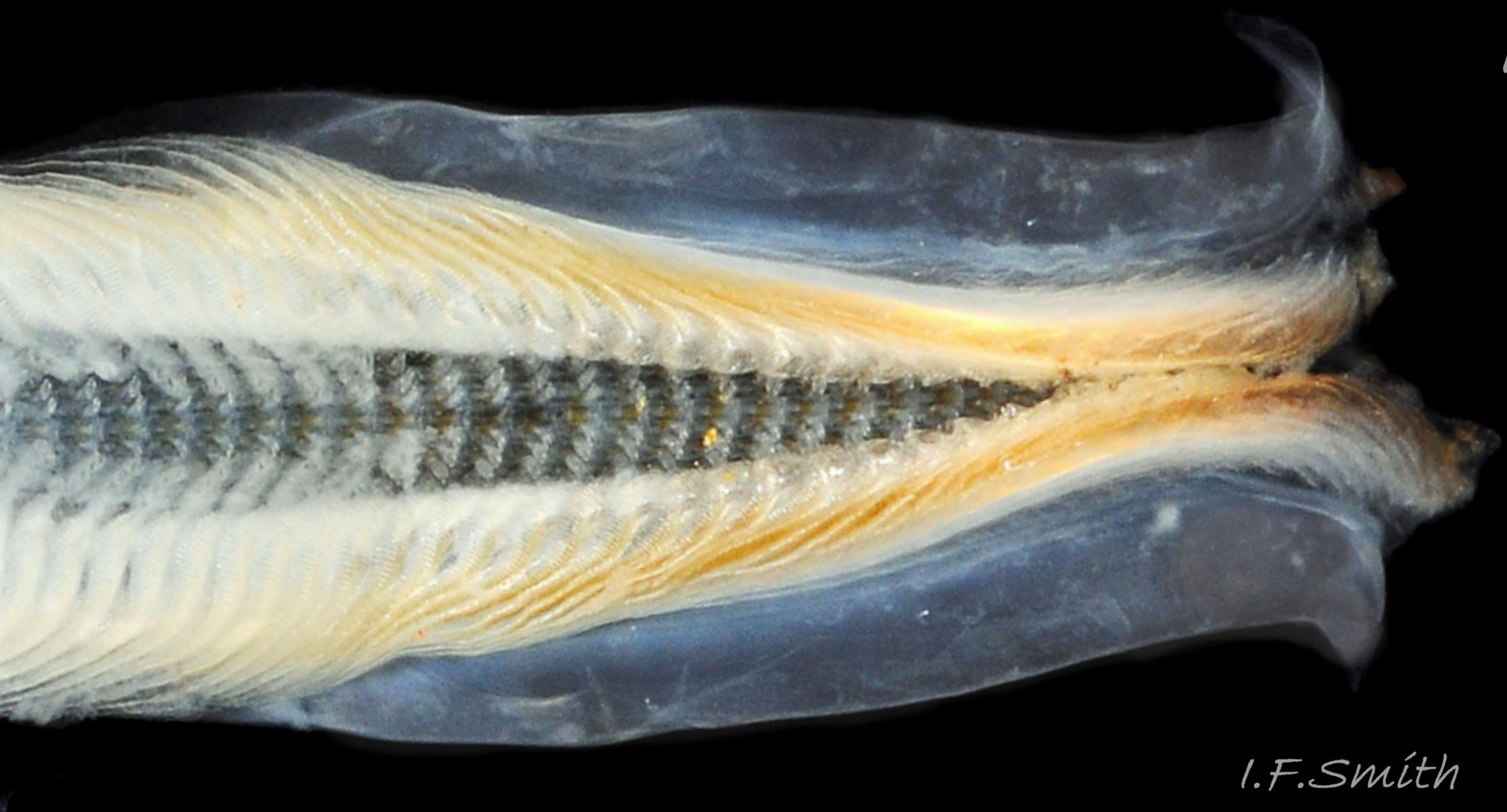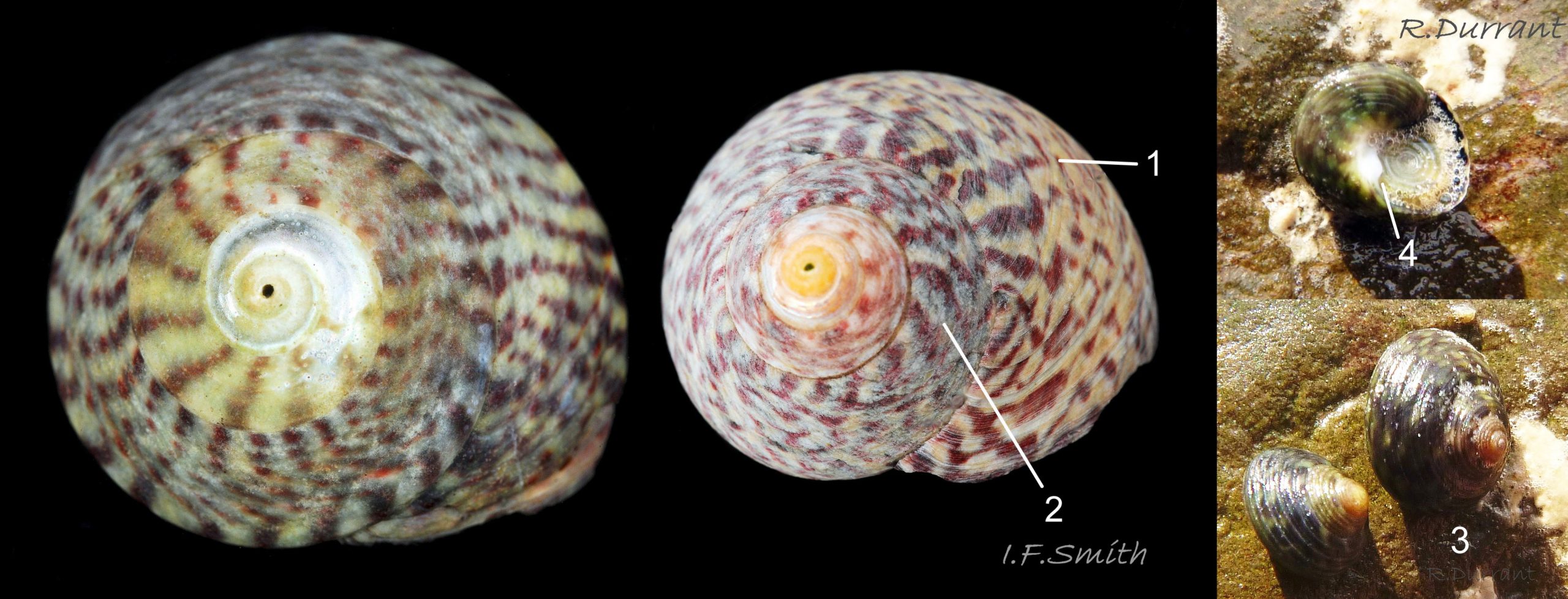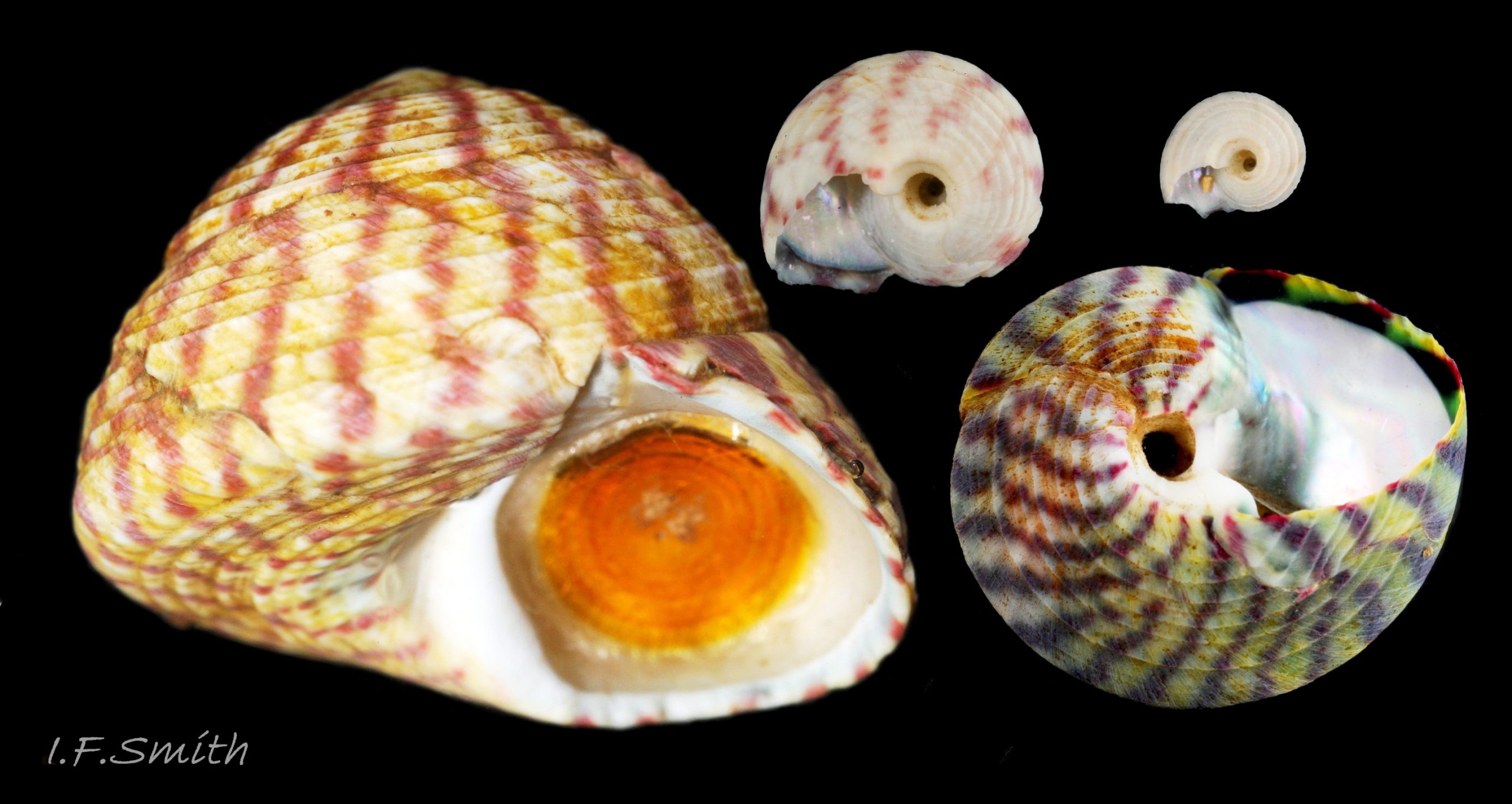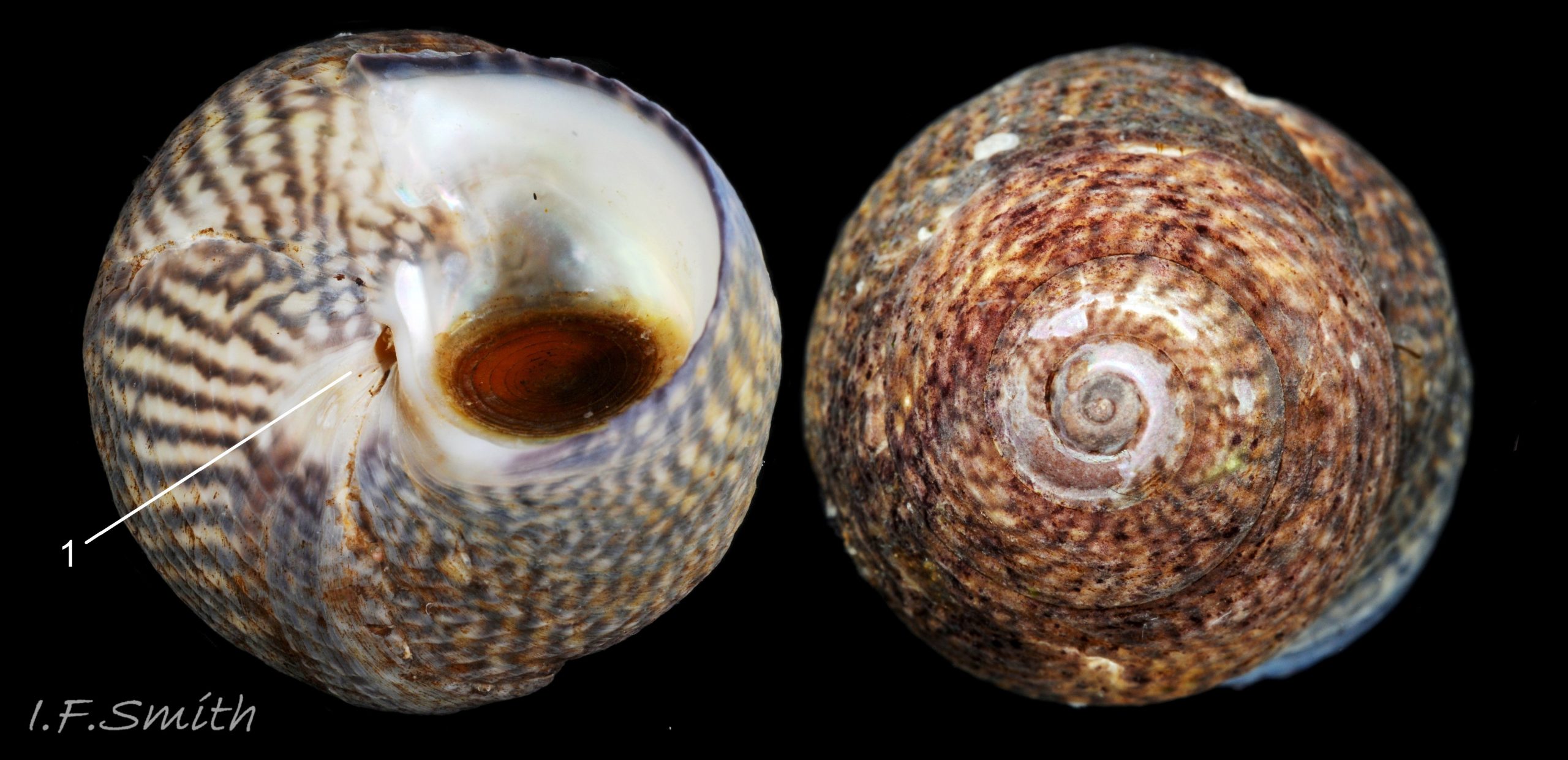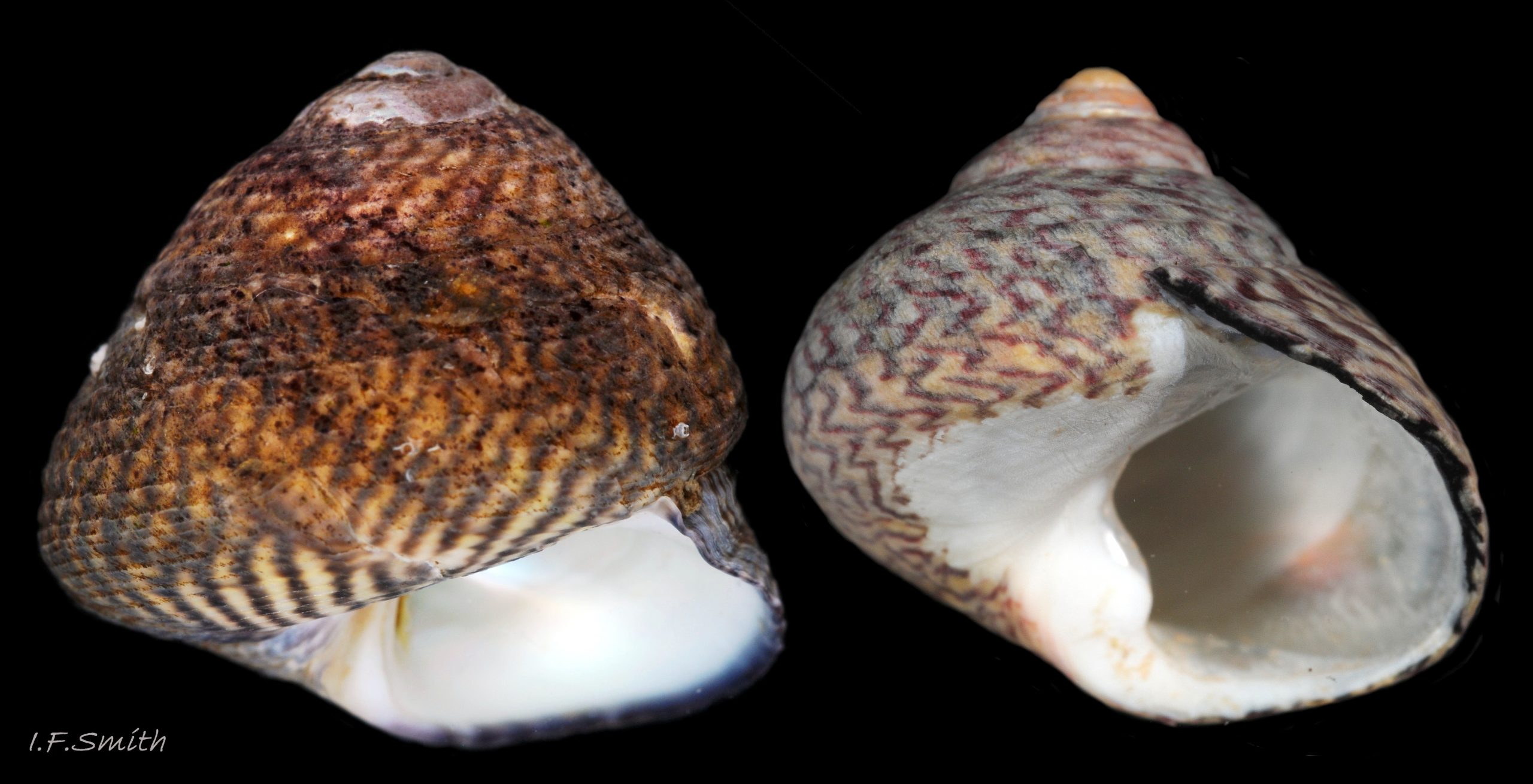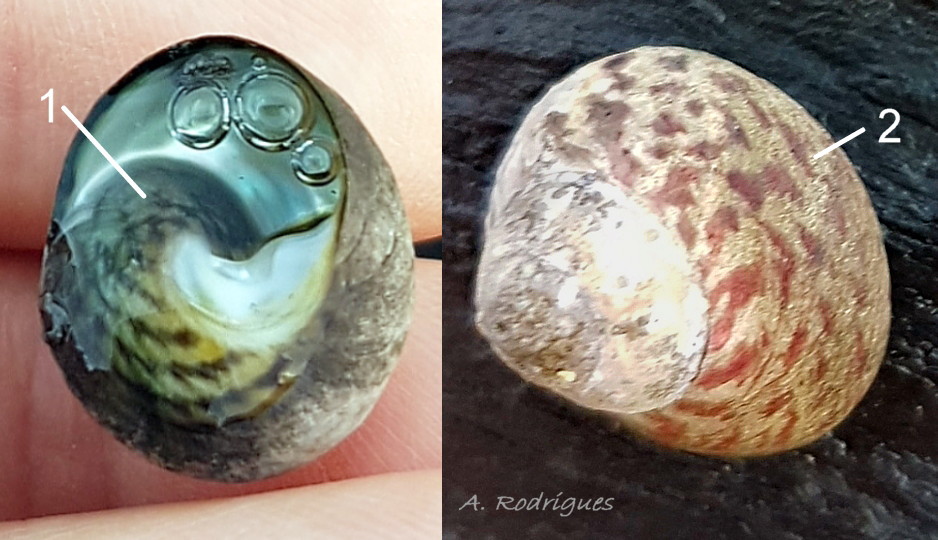Click image to enlarge with full caption. Main text below slider.
Phorcus lineatus (da Costa, 1778)
Anglesey, March 2014, revised January 2022.
PDF available at www.researchgate.net/publication/270585961_Phorcus_lineat… but lacks anatomy images 30 -39 and other revisions made in January 2022.
Current taxonomy: World Register of Marine Species (WoRMS) www.marinespecies.org/aphia.php?p=taxdetails&id=689176
Synonyms:Turbo lineatus (da Costa, 1778); Trochocochlea lineata (da Costa, 1778); Trochus lineatus da Costa, 1778 [in Jeffreys, and Forbes & Hanley]; Monodonta lineata (da Costa, 1778); Osolinus lineatus (da Costa, 1778); Trochus crassus Pulteney, 1799;
Meaning of name: Phorcus = Roman mythological character. lineatus = “marked, lined, streaked”. Synonym Monodonta = “single tooth”.
Vernacular: Toothed topshell; Toothed winkle; Large topshell; Thick topshell; Common topshell (English); Top môr danheddog (Welsh); Gewone tandtolhoren (Dutch); Gestrichelte Buckelschneke (German).
*GLOSSARY below.
Shell Description
Caution: description does not hold for specimens from Iberia.
Largest British trochid (top shell); breadth usually to 25 mm, height to 30 mm, exceptionally 34 mm. Shell-walls thick. Whorls swollen; sutures shallow. Conical profile steepens with growth.
Height relative to breadth is usually:
less than 80% when breadth is less than10 mm,
less than 100% when breadth is less than 20 mm
and less than 105% when breadth about 25 mm 01 Phorcus lineatus . Spire small; body whorl about 75%- 80% of height when breadth over 13 mm, but less than 80% of height on smaller specimens. The pointed apex is often eroded exposing the nacreous layer on large old specimens 02 Phorcus lineatus . Juveniles before their first winter (when about 7 mm breadth) have a sculpture of distinct spiral ridges and grooves, many fine transverse growth lines and a strong annual growth line where cold halts growth for the winter 03 Phorcus lineatus . Subsequent growth lacks distinct spiral ridges; fine growth lines may continue for a time, but eventually shell is usually smooth, apart from annual growth lines. Early sculpture is often eroded from large specimens. Juveniles 2 or 3 mm wide may have an open umbilicus, but it is usually completely sealed over by the time it is 5 mm wide, often leaving a dip or “scar” in the broad white columella 04 Phorcus lineatus , or, occasionally, a narrow, open crack 05 Phorcus lineatus . Adult aperture 40- 60% of height (can be about 80% on shells less than 12 mm broad) 01 Phorcus lineatus . The wide, white columellar lip has a strong protruberance or “tooth” below its midpoint. (Hence synonym Monodonta = “single tooth”) 04 Phorcus lineatus . The general outlines of the outer (palatal) and inner (parietal) lips form an obtuse angle, but the outer lip on un-eroded specimens flexes just before junction to make a small, acute, adapical angle 06 Phorcus lineatus . Externally, the ground colour of the opaque and lustreless shell is shades of buff 07 Phorcus lineatus , yellow 08 Phorcus lineatus , brown 01 Phorcus lineatus and/or green 09 Phorcus lineatus . Darker, more or less zigzag, transverse streaks of dark-brown, -green, -grey or –reddish purple run across the whorls, sometimes forming approximate bands radiating from the apex only on early whorls 10 Phorcus lineatus . Large adults usually have eroded spires exposing silver 07 Phorcus lineatus , occasionally pinkish 02 Phorcus lineatus , nacre. The interior of the shell has a substantial coating of silver nacre (aragonite) except for a narrow border within the outer lip which is coloured as the exterior. The nacre is often partly or completely masked by chalky-white surface layer which extends beyond the aperture onto the basal part of the body whorl 10 Phorcus lineatus . The circular spiral operculum has many narrow coils 11 Phorcus lineatus and is a transparent horn colour, darkening with age/growth. The pale opercular disc and some dark markings are usually visible through the operculum of live specimens 04 Phorcus lineatus .
Body Description
The ground colour of the body is various whitish, yellowish and/or greenish-yellow shades overlaid heavily in parts with other colours. The large snout, when at rest, ends in a circular tip with a vertical slit mouth (when closed) with diagonal slit extensions at each end delineating dorsal and ventral lips 12 Phorcus lineatus . The exterior surface of the snout is black with a whitish papillate rim 13 Phorcus lineatus . It is transversely wrinkled when contracted 14 Phorcus lineatus . The black shades into dusky brown as the snout merges with the rest of the head. Between the bases of the cephalic tentacles is a pair of smooth-edged, slightly undulated, cephalic lappets coloured dusky-brown 02 Phorcus lineatus , red-brown 15 Phorcus lineatus , grey or yellow 14 Phorcus lineatus .
The mouth opens by an initial outward movement of the lateral lips stretching the dorsal and ventral lips so the diagonals open out to form an approximately rectangular opening 16 Phorcus lineatus through which the odontophore 34 Phorcus lineatus & 35 Phorcus lineatus bearing the radula is thrust .Long marginal teeth 38 Phorcus lineatus & 36 Phorcus lineatus fan out widely, as they are pressed by the odontophore onto the substrate, and brush off surface particles. The marginal teeth curl back and, with the short lateral teeth 38 Phorcus lineatus , draw the swept particles into the mouth as the radula retracts.
The Cephalic tentacles are long, whitish often tinted yellow or faint purplish, with encircling black/ purple rings, dense fine setae and a dorsal groove 14 Phorcus lineatus . There is an eye on a stout peduncle at base the of each cephalic tentacle. The peduncle is yellowish-white ventrally 17 Phorcus lineatus and yellow, orange 14 Phorcus lineatus , scarlet and/or brownish 15 Phorcus lineatus dorsally. There is a large neck-lobe behind each eye. The right neck-lobe has smooth edge and is often curved into a part-siphon for exhalent water, gametes and faeces 18 Phorcus lineatus . Its dorsal surface is yellowish-white, yellow 19 Phorcus lineatus , or greenish-yellow 13 Phorcus lineatus . The ventral surface, which is usually darkened with brown, has a substantial whitish cylindrical peg 15 Phorcus lineatus ; it resembles a shorter peg at the base of epipodial tentacles. The right neck-lobe and eye peduncle are united with the epipodium. The left neck-lobe has a deeply digitated fringe coloured grey-green 20 Phorcus lineatus , yellow 12 Phorcus lineatus , or grey-yellow 21 Phorcus lineatus It is usually darker ventrally.
The dorsal surface of the foot is densely covered with longitudinal rows of roughly quadrilateral tubercles. The; tubercles are usually pale, with ash-grey in intervening grooves and on some tubercles 22 Phorcus lineatus .
The Epipodium is a well developed veil on each side of the foot, united with the neck-lobes and right (only) eye peduncle. It is usually held erect so the ventral surface is exposed on a live animal. The ventral surface may be coloured ash-grey like the dorsal surface of the of foot 18 Phorcus lineatus , but it often has combinations of yellow 19 Phorcus lineatus , ash-grey, orange 23 Phorcus lineatus and/or scarlet 24 Phorcus lineatus The epipodium bears three white, transversely lined with black-purple, setose epipodial tentacles arising from a whitish jagged sheath with an adjacent whitish, short, cylindrical peg 18 18 Phorcus lineatus . The yellowish-white dorsal surface of the epipodium is not often visible 18 Phorcus lineatus . The opercular lobe does not enfold any of the operculum edge 02 Phorcus lineatus .It is visible as a pale patch through the translucent operculum when the animal is retracted into the shell 04 Phorcus lineatus .
The sole is a yellowish white, broad oval with a papillate periphery 29 Phorcus lineatus , and many transverse furrows on either side of a medial line 25 Phorcus lineatus . The sole is whitish when expanded and pressed onto the substrate, tawny when contracted and out of contact with substrate or in a wave slightly raised from substrate 21 Phorcus lineatus .
The mantle is yellow 25 Phorcus lineatus or yellowish white near the anterior edge, becoming whiter with a slight pink tint further into the mantle cavity 26 Phorcus lineatus . Within the mantle cavity, the large canoe-shaped yellowish ctenidium 26 Phorcus lineatus and white rectum and anus 18 Phorcus lineatus are sometimes in view on live specimens; these and other organs are shown dissected in fig 30 30 Phorcus lineatus , 31 Phorcus lineatus , 32 Phorcus lineatus and fig 33 33 Phorcus lineatus . The upper body, usually concealed within the mantle cavity, is whitish, tinted pink to the rear of the head by the myoglobin-rich buccal mass 19 Phorcus lineatus & 34 Phorcus lineatus . Fertilization is external, so there is no penis on males.
Internal anatomy
Images 30 30 Phorcus lineatus , 31 31 Phorcus lineatus , 32 32 Phorcus lineatus , 33 33 Phorcus lineatus , 34 34 Phorcus lineatus , 35 35 Phorcus lineatus , 36 Phorcus lineatus, 37 37 Phorcus lineatus , 38 38 Phorcus lineatus & 39 39 Phorcus lineatus show the following features after removal of the shell:
30, 31: columellar muscle; a large muscle connecting the body to the shell at the columella; used to pull the body into the shell and the operculum to seal the aperture.
30, 31: mantle; a sheet of tissue that secretes the shell and covers the viscera with a thin translucent sheet.
32: hypobranchial gland; section of mantle which produces secretions to trap and cement particulate matter from the inhalent water current so it does not foul the ctenidium.
30: osphradium; an organ for testing inhalant water quality as it approaches the ctenidium.
30, 32, 33: ctenidium; a long comb-like gill with an axis bearing lamellae.
32, 33: skeleton of ctenidium; a white reinforcement of the anterior half of the axis of the long ctenidium.
33: lamellae of ctenidium; plate-like leaflets which take oxygen into the haemolymph flowing within them from the inhalent water as it passes between them.
30, 33: efferent branchial vessel of ctenidium; vessel along the axis of the ctenidium which takes oxygenated haemolymph from the ctenidium to the heart for pumping to the organs of the body.
31: pericardium; a sac containing the heart.
30, 32, 33: heart; consists in P. lineatus, and others in Trochidae, of a ventricle, with the rectum running through it, flanked anteriorly by a left auricle and posteriorly by a right auricle.
30: left (anterior) auricle of heart, receives haemolymph from ctenidium and forces it into a ventricle.
30: anterior aorta; an artery which takes the oxygenated haemolymph forwards from the ventricle of the heart to the foot and head.
34, 35: buccal mass; contains the anterior of the radula, an odontophore and muscles red with myoglobin which supplies the oxygen they require.
34, 35: odontophore; approximately ellipsoid structure containing a pair of cartilaginous bolsters which support the radula. Protruded and retracted like a tongue to operate the radula.
34, 35: cartilaginous bolsters; main part of the odontophore.
32, 33: radular sac; teeth of radula commence growth at rear of the sac and grow and mature as they move towards the anterior of the radula.
34, 35, 36, 37, 38: radula; chitinous ribbon of teeth.
38, 39: radular teeth; in rhipidoglossan arrangement of multiple rows with a central rachidian tooth flanked on each side by five small lateral teeth and numerous, needle-like, long marginal teeth.
34, 36, 39: hyaline shield; transparent, lateral flanges of radula at anterior where it rests on the odontophore; attachment surface for muscles that retract the radula.
30, 31, 32, 33: digestive gland; absorbs digested food.
30: left kidney; smaller than right kidney; located in mantle. A resorptive organ, which removes non-nitrogenous, soluble materials such as glucose from the haemolymph.
32: left kidney opening.
31, 32, 33: right kidney; at base of visceral mass; primary organ for eliminating nitrogenous waste from the haemolymph; large size enables retention of urine during the slow resorption process. Cells produce substances, probably of dietary origin, responsible for the dark green colour.
32: right kidney opening; exit point for urine and male or female gametes.
32, 33: intestine and 30, 31, 32, 33: rectum are looped and long to facilitate resorption of water from faeces and to compress them into firm rods that will not foul the ctenidium located near the anus in the mantle cavity.
32: anus.
30, 31, 32, 33: gonads; Colour similar in both sexes, except February – May when ovaries are green and testes pink or cream. www.marlin.ac.uk/species/detail/1324
Key identification features
Phorcus lineatus
1) Shell grows much larger than Steromphala umbilicalis and S. cineraria; to about 30 mm high and 25mm broad 01 Phorcus lineatus
2) Shell, ground colour shades of buff 07 Phorcus lineatus , yellow 08 Phorcus lineatus , brown 01 Phorcus lineatus and/or green 09 Phorcus lineatus . Darker, more or less zig-zag, transverse streaks of dark-brown, -green, -grey or –reddish purple run across the whorls; only arranged into approximate bands radiating from the apex on early whorls 10 Phorcus lineatus . Shells under 15 mm width, from above can resemble S. umbilicalis of similar size 40 Phorcus lineatus COMPARISON Steromphala umbilicalis .
3) Umbilicus is completely sealed over by the time the shell is 5 mm wide, often leaving a dip in the columella 04 Phorcus lineatus .Occasionally there is a narrow, open crack 05 Phorcus lineatus . Iberian specimens often have an open umbilicus.
4) Rounded tooth on columella 04 Phorcus lineatus .
5) Shells up to 10 mm wide have a low profile; largest ones are taller than wide 01 Phorcus lineatus .
6) Dorsally the foot is yellowish heavily overlaid with ash-grey. The snout is black. 22 Phorcus lineatus .
7) Whitish cylindrical peg projects from ventral surface of smooth edged right neck-lobe 15 Phorcus lineatus .
8) In Britain, south and west coasts between Isle of Wight and Llandudno. Most of Ireland. Sporadic near limits which fluctuate; recede after cold winters.
Similar species
Steromphala umbilicalis (da Costa, 1778)
1 up to 16 mm high, 22 mm wide.
2) Shell has broad red to reddish-purple bands radiating from apex across all its whorls 40 Phorcus lineatus.
3) Shell always has a large round umbilicus at all growth stages 41 Phorcus lineatus.
5) Shell profile usually low, but sometimes quite high 41 Phorcus lineatus.
6) Much dark pigment on soft parts. On withdrawn specimen, dark pigment is seen through about 50% of operculum.
8) In Britain, found from Kent along south and west coasts round onto north coast Scotland, with a few records on the west coast of Orkney.
Steromphala cineraria (Linnaeus, 1758)
1 Up to 16 mm high, 16 mm wide.
2) Shell has grey or bluish grey bands radiating from apex across the whorls 42 Phorcus lineatus & 43 Phorcus lineatus.
3) Umbilicus progressively narrows with age; may be very restricted or completely closed fig 42 42 Phorcus lineatus.
5) Shell profile of fully grown 15 mm high S. cineraria may be like a traditional bee-hive 3 43 Phorcus lineatus, but P. lineatus does not achieve a similar high shouldered profile until much larger.
6) Soft parts whitish with varying black or grey marks.
Phorcus sauciatus (Koch, 1845)
1) Up to 25 mm high.
2) Similar external colours to P. lineatus but instead of zigzag marks it usually has thick reddish marks 44 Phorcus lineatus, often as dashes orientated spirally. But sometimes very difficult to distinguish externally. Diagnostic band of exterior colour extends far into the aperture 44 Phorcus lineatus.
3) Umbilicus is completely sealed over often leaving a dip in the columella.
4) Rounded tooth on columella.
5) Shell profile similar to P. lineatus; low when young, high when older.
8) From Canary Islands, Madeira and Mauritania to north coast of Iberia; not in Mediterranean (Donald et al., 2011). Precise limits vary, spreading at its northern limit.
Habits and ecology
P. lineatus lives on open surfaces on rocky shores, usually fairly sheltered to very sheltered, Ballantine (1961) exposure scale 5-7. Sometimes it is found on exposed or semi-exposed shores, scale 3 & 4, if there is local shelter from stable boulders, broken reefs etc. It is not usually on large vertical surfaces, mobile shingle or under a dense cover of fucoids.
Juveniles, less than 5 mm wide, are usually lower down the shore than adults, concealed in crevices or in pools with a gravel floor. Adults are usually most frequent just below HWN where they are exposed to air 60-50% of time, but local terrain, season and age cause variation so they may sometimes occur at any level. They do not live sublittorally; distribution is controlled by winter air temperature. Many British populations were destroyed in the severe winter of 1963, but have since recovered and expanded northwards with the warming climate. They are able to withstand high summer temperatures; often fully exposed to summer-sun on the top of bare boulders, moving down to shelter in cold spells and during winter. They may be found near the surface of rock pools as the tide falls 27 Phorcus lineatus , but they usually soon crawl out.
Respiration, cilia on the left neck-lobe vibrate to create an inhalent current to the large canoe-shape ctenidium within the mantle cavity 26 Phorcus lineatus . The deeply digitated fringe on the lobe probably acts as a guard against detritus and may sense poor water conditions. Cilia on the smooth edged right neck-lobe create an exhalent current for respiratory water, ova or sperm, and faeces from the proximate anus 18 Phorcus lineatus . During long daily exposure to the atmosphere, P. lineatus breathes air with the well vascularised surface of the mantle cavity. On re-immersion, air is expelled as bubbles over the exhalent right neck-lobe 28 Phorcus lineatus .
Locomotion is enabled by ditaxic, direct compression waves on the sole of the foot 29 Phorcus lineatus ; turning is caused by different rates of wave flow on either side of the medial line, or even reversal of direction to retrograde on one side. It can travel 6 metres in two days. As it moves, it gently rocks from side to side and exudes copious mucus left as a dual stepped-trail on dry rocks. Sensory tentacles, cephalic and epipodial, wave around as it travels.
It feeds by brushing its fine, multi-toothed radula, with teeth as soft as human hair, over rocks finely coated with algal felt or detritus to sweep up diatoms. It breeds in Britain from May to August or September; dates vary at different locations. External fertilization occurs as the ova are released individually, a few at a time or in quantity, via the right neck-lobe from mantle cavity. Ova, initially 0.15- 0.2 mm diameter, swell to 0.5 mm as the gelatinous coat swells with seawater. They float for 20 minutes then sink as the gelatinous coat detaches. Veliger larvae hatch 10 to 30 hours later. They probably stay on or close to sea bed as they are rarely, if ever, are caught in plankton nets. They metamorphose into adult form with a shell 1 to 2 mm high and settle after 3 to 6 days. The short, weakly-planktonic stages of ova and veligers is unsuited to distant dispersal. Growth is rapid until cold halts growth at 7 to 8 mm width around November. Growth restarts in May or June. They are about 10 mm wide when one year old. Maturation (gametogenesis) starts in the second autumn when at least 11 mm wide. The are about 15 mm wide when the second winter growth halt occurs and are ready to breed the following spring and summer. P. lineatus frequently lives to 9 years and occasionally to 15 years or more. Sites with very favourable conditions for reproduction may have dense populations of P. lineatus with growth restricted by competition for food, while less suitable sites may have fewer but larger specimens.
Distribution and status
P. lineatus occurs from Morocco to Ireland and south-west Britain; not in the Mediterranean (Donald et al., 2011). GBIF map www.gbif.org/species/7992320 . In Britain it is reliably recorded from south and west coasts between the Isle of Wight and Llandudno. It is found round most of Ireland, including the Irish Sea coast of Northern Ireland, though it is absent from the English side of the north east Irish Sea because Anglesey deflects the mild winter Atlantic drift away from that coast. Near its northern limits, its occurrence fluctuates with the weather, receding after cold winters such as in 1963 (Crothers, 2001).U.K map NBN species.nbnatlas.org/species/NHMSYS0021056527 S.E. Scotland records (2009) are certainly mis-identifications; other Scotland records are a unlikely and need substantiation with specimens or clear photographs.
Acknowledgement
I thank Rob Durrant and Ana Rodrigues for use of images.
Links and references
Ballantine, W.J. 1961. A biologically-defined exposure scale for comparative description of rocky shores. Field studies1(3): 1-19. fsj.field-studies-council.org/media/344345/vol1.3_17.pdf
Crothers, J.H. 2001. Common topshells: an introduction to the biology of Osilinus lineatus with notes on other species in the genus. Field studies, 10: 115-160.
fsj.field-studies-council.org/media/342011/vol10.1_265.pdf
Donald, K., Preston, J., Williams, S. T., Reid, D., Winter, D., Alvarez, R., Buge, B., Hawkins, S., Templado, J., & Spencer, H. 2011. Phylogenetic relationships elucidate colonization patterns in the intertidal grazers Osilinus Philippi, 1847 and Phorcus Risso, 1826 (Gastropoda: Trochidae) in the northeastern Atlantic Ocean and Mediterranean Sea. Molecular Phylogenetics and Evolution, 62(1), 35-45.
da Costa, M.A. 2015. Distribution and Shape Analysis of Phorcus lineatus and Phorcus sauciatus along the Portuguese Coast. Dissertation for Universidade de Lisboa, Faculdade de Ciências, Departamento de Biologia Animal. repositorio.ul.pt/bitstream/10451/22587/1/ulfc116019_tm_M…
Forbes, E. & Hanley S. 1853. A history of the British mollusca and their shells. vol. 2 London, van Voorst. (As Trochus lineatus,). archive.org/details/historyofbritish02forb/page/524/mode/2up
Fretter, V. and Graham, A. 1962. British prosobranch molluscs. London, Ray Society.
Graham, A. 1988. Prosobranch and pyramidellid gastropods. London.
Jeffreys, J.G. 1865. British conchology. vol. 3. London, van Voorst. (As Trochus lineatus). archive.org/details/britishconcholog03jeffr/page/316/mode…
Lewis, J.R. 1964. The ecology of rocky shores. London, Hodder & Stoughton.
Trigo, J.E.; Diaz Agras, G.J.; Garcia Alvarez, O.L.; Guerra, A.; Moreira, J.; Pérez, J.; Rolán, E.; Troncoso, J.S,; Urgorri, V.. 2018. Guia de los Moluscos Marinos de Galicia. Servicio de Publicacións da Universidade de Vigo.
Current taxonomy: World Register of Marine Species (WoRMS) www.marinespecies.org/aphia.php?p=taxdetails&id=689176
Glossary
adapical = towards the apex of the shell.
aperture = mouth of gastropod shell; outlet for head and foot.
aorta = principal artery which takes the oxygenated haemolymph from the heart to the body.
auricle = chamber of heart that receives blood from the ctenidium.
bolster = pillow-shaped structure providing support.
buccal mass = anterior of digestive system including an odontophore and muscles.
cartilaginous = made of, or resembling, cartilage.
cephalic = (adj.) of or on the head.
cilia = (pl.) vibrating linear extensions of membrane used in feeding or locomotion. (“cilium” singular).
ciliated = (adj.) coated with cilia.
columella = solid or hollow axial “little column” around which gastropod shell spirals; hidden inside shell, except on final whorl next to lower part of inner lip of aperture where hollow ones may end in an umbilicus or siphonal canal.
columellar = (adj.) of or near central axis of spiral gastropod.
columellar lip = lower (abapical) part of inner lip of aperture.
columellar muscle = large muscle connecting the body to the shell at the columella.
diatom = microscopic aquatic alga with siliceous cell-walls.
ctenidium = comb-like gill with an axis bearing lamellae.
ditaxic = (of locomotion waves on foot) double series of waves, out of phase with each other, one series on each side of central furrow on sole.
direct = (of locomotion waves on foot) waves travel from posterior to anterior.
efferent = conducting outward away from an organ.
ELWS = extreme low water spring tide (usually near March and September equinoxes).
gametes = reproductive cells; sperm or ova.
haemolymph = circulating fluid in molluscs that carries nutrients, waste and hormones. Analogous to vertebrate blood, but most molluscs have copper-based haemocyanin in it, instead of red haemoglobin, to carry oxygen. It may be tinged blue when oxygenated; colourless when depleted of oxygen.
height = (of gastropod shells) distance from apex of spire to base of aperture.
hyaline = glassy and translucent.
hyaline shield = transparent, lateral flanges of radula at anterior where it rests on the odontophore; attachment surface for muscles that retract the radula.
hypobranchial gland = section of mantle which produces secretions to trap and cement particulate matter from the inhalent water.
lamellae = plate-like leaflets.
mantle = sheet of tissue that secretes the shell and forms a cavity for the gill in most marine molluscs.
myoglobin = red oxygen-binding protein in muscle tissue; often in buccal-mass muscles of gastropods. Similar to red haemoglobin in vertebrate blood, but green haemocyanin is usual oxygen-carrier in mollusc blood. See www.researchgate.net/publication/251227038_Radular_myoglo…
odontophore = approximately ellipsoid structure containing a pair of cartilaginous bolsters which support the radula. Protruded and retracted like a tongue to operate radula. Usually reddish from myoglobin, and medially grooved.
opercular = (adj.) of the operculum.
opercular disc = part of foot that growing operculum rotates on.
opercular lobe = extension of opercular disc round edge of part of operculum.
operculum = plate of horny conchiolin used to close shell aperture.
osphradium = organ for testing inhalant water quality.
papilla = (pl. papillae) small cone-shaped protrusion of flesh.
papillate = covered in papillae.
pericardium = sac containing the heart.
periostracum = thin horny layer of chitinous material often coating shells.
plankton = animals and plants that drift in pelagic zone (main body of water).
radula = chitinous ribbon of teeth; extended on odontophore to rasp food.
resorb = to break down and assimilate the components of.
resorption = the action or process of resorbing something.
retrograde = (of locomotion on foot) waves travel from anterior to posterior.
setose = bearing many setae.
seta = stiff hair or bristle. (pl. setae).
suture = groove or line where whorls of gastropod shell adjoin.
trochophore = spherical or pear-shaped larvae that swim with aid of girdle of cilia. Stage preceding veliger, passed within gastropod egg in most spp. but free in plankton for limpets and Trochidae.
umbilicus = cavity up axis of some gastropods, open as a hole or chink on base of shell, often sealed over.
veliger = shelled larva of marine gastropod or bivalve mollusc which swims by beating cilia of a velum (bilobed flap).
ventricle = chamber of the heart which receives haemolymph from an auricle and from which haemolymph is forced into the arteries.
